 |
|||||||||
Classical Editor: Rob Barnett
Music Webmaster
Len Mullenger:
Len@musicweb-international.com
|
Classical Editor: Rob Barnett
|
||||||||||||||||||||||||||||||||||||||||||||
February 1999 |
||
|
|
||
© Music on the Web(UK) 1999. All rights retained. Reviewers retain copyright on their reviews. Disclaimer
![]() COMPETITION WIN
a CD of your Choice from Crotchet
COMPETITION WIN
a CD of your Choice from Crotchet
![]()
ARENSKY Egyptian Nights Moscow SO/ Dmitry Yablonsky
MARCO POLO 8.225028 (50:43)
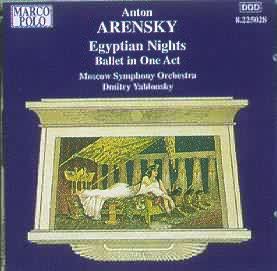
This is ballet music written in the true classical Russian ballet tradition. Arensky has employed basic North African musical forms in movements like the Dance of the Egyptian Girls but blended them with familiar Slavonic idioms in such a way that the 1908 audience must have felt as though it had barely left St. Petersburg. ln fact the "Pas de deux" Tempo di valse sounds rather incongruous.
Here is a very brief idea of the story to help readers visualise the mood of the music and the production of the ballet. Amoun an accomplished hunter and friend of the High Priest, is betrothed to nice country girl Berenice. Then Cleopatra arrives and Amoun is smitten by her beauty to such an extent that he shoots an arrow into a tree above her head with a message attached declaring his love. Cleopatra is not amused. Even though she is struck by Amoun's handsome good looks and grants him the kiss he desires, she orders that he must die by poison, at the first light of day. Mark Anthony appears and goes off with Cleopatra after Amoun has drunk the lethal potion. But the ballet ends happily for the High Priest has given Amoun only a harmless drug and he is reunited with the for-giving Berenice.
The Music is pleasant enough throughout if not particularly memorable. The influence of Tchaikovsky is very apparent: so too is that of Rimsky-Korsakov (Arensky was one of his students). Not surprisingly therefore, Arensky's instrumentation is sparkling and very colourful. The music often suggests languid, perfumed nights in lush, sensuous surroundings, and it is frequently delicate and gossamer-like. The contrasting ceremonial music for the arrival of Cleopatra and, later, Mark Anthony is suitably imposing and. once or twice, it sounds oddly Elgarian.
The Moscow Symphony Orchestra clearly revels in this repertoire and it plays with spirit and enjoyment. Soloists Alexander Avratnenko (violin) and Vladimir Kolpashnikov (cello) shine in their movements (erroneously credited on the CD's cue page). Avramenko's ardent, romantic playing in the Poisoning Scene suggests that Cleopatra's kiss before the lethal brew is handed to Amoun, must have been lingering and passionate.
An enjoyable bit of escapism.
Reviewer
Ian Lace
tar.gif)
"This review originally appeared in Fanfare (Nov/Dec 1997) and is reproduced by kind permission of that publication"
Howard BLAKE A Month in the Country; Violin Concerto "The Leeds"; Sinfonietta for 10 brass instruments . Christiane Edinger (violin) English Northern Philharmonia conducted by Paul Daniel
ASV CD DCA 905
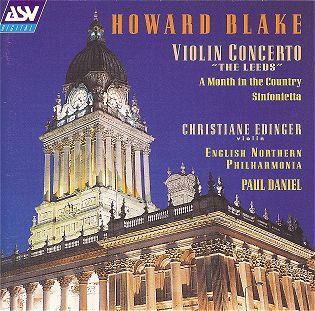
If you like lush, Romantic music, look no further. This is a magnificent, accessible concerto from the composer of the music for the highly successful animated film of The Snowman. It is the sort of music that any film producer would give his eye teeth for - dramatic, heroic, atmospheric and lyrical with beautiful soaring melodies but above all it is resolutely tonal. It was commissioned by Leeds City Council for the Leeds 1993 City Centenary, hence its title, although judging from Howard Blake's own CD booklet notes, there is no programme. It is absolute music to be enjoyed in its own right; nonethless, one is occasionally tempted to guess at some extra musical influence - for instance, the a robust passage for brass in the lengthy first movement that might describe the forthright but dependable Yorkshire personality. Christiane Edinger rises, with aplomb, to its technical challenges, especially in the bravura third movement with its quadruple stoppings, pizzicati and dazzling broken chords. Daniels provides a thrilling and sensitive accompaniment. The sound throughout this programme is excellent.
For the 1986 Euston Films/Channel 4 film A Month in the Country, Blake wrote a sympathetic score which ideally suited this story of two former soldiers coming to terms with the horrors of the Great War amidst the serenity of the English countryside. This suite for strings contrasts lyrical, pastoral music recalling Warlock, Vaughan Williams, Delius and Finzi (yet never swamping Blake's own melodic style) with other movements suggesting soldiers' trudging marching figures, and the despair and waste of war.
The Sinfonietta for brass instruments (1981) is a brilliant and colourful work with an imposing Maestoso first movment, a techically innovative and demanding Andante and a vivacous Presto.
Recommended
Reviewer
Ian Lace
tar.gif)
(CD cover shows the Victoria Town Hall, Leeds)
| ERNEST
BLOCH (1880-1959) - BLOCH PERFORMS BLOCH
Schelomo (Hebrew Rhapsody)
for cello and orchestra (1916) *, From Jewish Life for cello
and piano (1924) **, Sacred Service (Avodath Hakodesh) for
baritone, choir and orchestra
***.
The CD can be ordered from the Trust for £13.49 plus £1 Post and Packing in UK and £2 outside UK. Phone 0181 909 2445 Fax 0181 909 1030. E-mail enquiries to jewishmusic@jmht.org. (please check that these prices are still valid) |
|
|
|
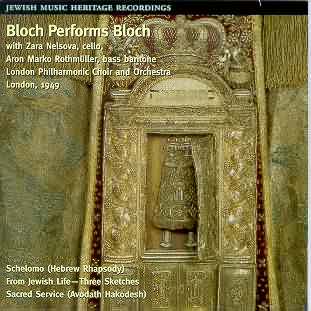
I have been interested in the music of Ernest Bloch ever since hearing a Radio 3 broadcast of his opera Macbeth (Swiss Radio recording). Later I heard Schelomo, the Rhapsody America, the Violin Concerto (Menuhin) and the Concerti Grossi. I had heard the Sacred Service before in an earlier Chandos recording (CD release - 1989) but it made little impact at the time.
Jewish Musical Heritage Recordings have done a great service to music-lovers and collectors (not always exclusive categories!) by reissuing these recordings from the Decca archive. They comprise recordings made by Bloch during his visit to London in 1949 and were associated with concert performances. The celebrity point of the visit was the premiere of his 1949 Concerto Symphonique for piano and orchestra. This was premiered at the Edinburgh Festival and broadcast live on the then Third Programme (BBC). The soloist was American pianist Corinne Lacomblé. The composer conducted. Unfortunately that work was not recorded at the time .. at least not commercially by Decca. Does it survive on acetate somewhere?
The concerts including a Prom offered Schelomo (soloist Nelsova), Suite Symphonique (1944) and the first performance in London of Sacred Service. The artists went into the Decca recording studios shortly afterwards. Schelomo has been recorded by many cellists but this is something special being both a vibrant projection of the music and one conducted by the composer. Nelsova herself studied the work with the composer and of her three recordings said she liked the one with him (the first) the best.
These are al lhistoric recordings in mono and they do not have the sonic richness of a modern recording. They do however have an immensely more vibrant musical richness (try Schelomo at 7:03). The years have taken their toll on the sound quality which can be coarse-grained. This is especially noticeable at the start of Schelomo. The ears soon adjusts to this. The work itself is inspired by the Book of Ecclesiastes and Vanity of Vanities. Bloch’s own notes refer to the work’s momentary joy in sensual pleasures and the sharpness and utter negation inherent in the realisation that it is all evanescent. This sense of negation ends the work. Nelsova seems to have absorbed the essence of the work and projects it with conviction. I came to know the Dvorák Cello Concerto through a tape of one of Nelsova’s BBC broadcasts. It is good to hear her again and I can only hope that she will be invited back to perform with the London and other British orchestras.
The Three Sketches ‘From Jewish Life’ (cello and piano) are soulfully gentle, tentative and quietly exotic. There are no grand outbursts. Instead the mood is sustained across all three brief movements. Nelsova brings the same concentration and inwardness to her playing that we hear in Schelomo.
Sacred Service has not had that many recordings over the years. I can recall the Chandos LP and was there a Bernstein version? The recording quality is the best of the three works here and the choral singing comes over with satisfying depth. The orchestral passages (track 5) come over with a glittering savage grandeur. Interesting that the devotional atmosphere is contrasted with a certain wildness. Aron Marko Rothmüller’s voice is darkly intense although at times his slight vibrato is a distraction and he clearly finds Lift Up Your Heads a strain. At track 6 3:10 there is an exotic march-like figure which seems to stride right out of a Vaughan Williams (or Holst) choral score. There are many attractions in the score but overall the steady pacing and consistently elevated tone of the work does not consistently hold the attention .. or at least not mine. The performance seems dedicated as would be expected.
I rather hope that JHMT will now seek out other archive recordings of Bloch. Any chance of finding a decent tape of Macbeth (I predict widespread interest in that one)? Concerto Symphonique is on a Vanguard CD. The Rhapsody ‘America’ is on Delos. I believe there is a commercial recording of the Israel Symphony (Vanguard again) but I have never seen a recording of the very early ‘Symphonic Fresco’ Helvetia. Interesting that Bloch chose to celebrate his birth and adopted homelands in such an explicit way. Recordings of the Symphonic Suite, Concerto Grosso for quartet and strings and the viola concertino would be interesting.
There are thorough notes by Alexander Knapp and an interview with Zara Nelsova (happily still with us). Nelsova reminisces about the composer and her visits to his Oregon home. This reminds us that in researching the life and music of a composer CD booklets must not be ignored. The booklet is splendidly detailed. Trilingual notes (English French German).
This generously-timed CD recommends itself very strongly to Bloch enthusiasts. Nelsova fans will also do well to get the disc as will anyone concerned with performance styles and the role of the composer as conductor/performer. For the general listener Schelomo would be the best introduction to Bloch and there are quite a few modern stereo recordings around although I doubt that many can match the musical spirit of Nelsova’s and Bloch’s partnership. This disc represents a wonderfully rewarding project bringing largely forgotten though important recordings back into availability.
Reviewer
Robert Barnett
tar.gif)
I would be very interested to hear of any private non-commercial radio tapes that may exist documenting Bloch’s conducting of or involvement in his other works. It would be surprising if none existed given that he died in 1959.
| WALTON
Violin Concerto (1939) *
BRITTEN Violin Concerto
(1939 rev 1950) ** |
|
|
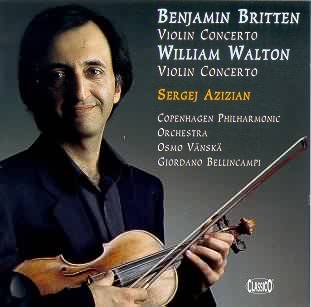
Two romantically-inclined English violin concertos played by a Russian violinist working in Denmark, a Danish orchestra plus two conductors, one Finnish, the other Italian - all recorded by a Danish label.
These words are by way of introduction, not criticism. I am not a believer in the only true voice for British music being by British artists. The chances of good music travelling would be virtually non-existent without orchestras worldwide being willing to explore and record music from other states and cultures.
The self-same coupling of concertos exists in the EMI catalogue where the soloist is the vivaciously-toned and fiery Ida Haendel (Bournemouth SO/Paavo Berglund). That recording dates from the 1980s and is now rather long in the tooth though astoundingly freshly-minted as a performance.
The two concertos date from the same year, written in the shadow of World War 2. Their composers stand at opposite ends of the style divide and yet these two concertos are spiritually close. The Britten is amongst his most romantic works running contrary to his usual style. The Walton is a vital example of his own true language.
Azizian is a powerful player though occasionally harsh in the sounds he conjures. He does not have the high-powered consistently tense approach of a Heifetz or an Oistrakh.
The Britten concerto performance rates highly, delicately stepping the line between neo-classicism and neo-romanticism, leaning more often into the latter. Vanska already has a well-justified and good reputation arising from his work with BIS and with the BBC Scottish SO. From the V-for-Victory figure at the opening through to the Prokofiev echoes (violin concerto No 1) and the uncharacteristic (for Britten) relaxation into succulent romance, this performance is extremely engaging and is in good sound. Only in the third movement before the twittering and flickering fantasy interlude does the work seem to wander and lose concentration.
Vanska surrenders the podium to (the, to me, totally unheard of) Giordano Bellincampi for the Walton concerto.
The Walton work (with its heritage in Elgar's much earlier concerto) is a classic of late late-romanticism; a passionate (Heifetz-dedicated and championed) work both loving and erotic, soaked in a Mediterranean glowing blue-green sea-swell. It is a work which appeals to me strongly. I rate the no-holds-barred recordings by Zino Francescatti (CBS/Sony) and Ida Haendel (EMI) very highly.
The first movement is nicely pitched in terms of breathing ebb and flow. What leaves me feeling dissatisfied is the recessed balance of the orchestra in which Walton has embedded much of the poetry of the work. Azizian is passionate and driven although he is not aided by an orchestra or recording that presents the ensemble as having a less than silkily sumptuous and golden upholstered sound. There is much to enjoy, not least the myriad moments of artful colouring presented by Azizian. He has a good sense of fantasy. The orchestra sounds somewhat disengaged and the outlines of the climactic spasm at 8:30 (first movement) are softened and blurred. This happens quite often in the orchestra and is a definite disadvantage. So what we have here is a very strong and poetically motivated soloist whose identification with the 'jolt and charge' of the music seems not to be consistently matched by the orchestra.
The helpful notes are in English only and are by the 'house' writer for ClassicO, Mogens Wenzel Andreason.
The playing time is not that generous by many standards but is perfectly respectable as indeed are the performances. There is nothing here that would put off the first time listener to these works. Clarity and a natural approach to recording balance have a great deal to commend them. I expect to hear more of Azizian on the international stage and in due time this recording is likely to become a collectors' item amongst violinist fanciers.
Reviewer
Rob Barnett

| Anton
BRUCKNER Symphony No.4 in E flat major, "Romantic"
(1878/80 version, ed. Haas)
|
|
|
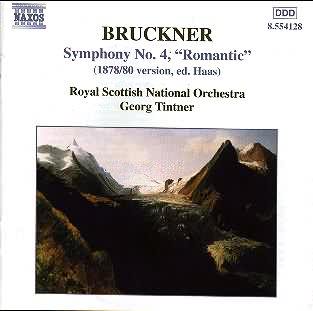
I was prompted to hear this recording after reading so many glowing reviews by mycolleagues. Is it as good as they say it is? Yes, it is! Tintner's dedication and scrupulously meticulous attention to Bruckner's enormous, monumental score is clearly evident in every bar.
Tintner's Bruckner scholarship deeply impresses too, as his CD booklet notes reveal. How many other conductors will insist on this level of commitment?
Tintner is exemplary in his pacing, phrasing and shading, carefully controlled crescendos - beginning softly and working slowly, inevitably but unhurriedly forwards - and in his terracing of the great majestic climaxes to achieve the maximum impact that Bruckner surely desired. The misty, hushed strings opening of the first movement with its horn calls and answering woodwinds is magical. Just listen to how seamlessly yet powerfully Tintner shapes this opening into the radiant main theme with its glorious fanfare decorations. Tintner offers some fascinating interpretative insights of the detail of this movement in his notes.
The gentle funeral march and the lovely long-spanned song for the violas supported by the plucked notes of the other strings of the second movement is handled with considerable finesse while the famous hunting scherzo horn music blazes out most thrillingly. (Tintner tells us that the "... wonderful Trio represents the hunters unpacking and eating their cheese!").
This symphony was written originally in 1874 but Bruckner radically revised its detail in 1877-78.
In 1880 he composed yet another Finale and this is the version that is usually played (as in this performance). As Tintner says: "It is considered by some to be sombre for the rest of the work, but I do not share this view and think it is the crowning glory of this wonderful symphony..." His glowing and majestic reading, contrasting light and shade, innocent charm and strong assertive heroics, is a strong advocate for his argument. This has to be the new benchmark recording of Bruckner's 4th Symphony.
Reviewer
Ian Lace

| EISLER
The Hollywood Songbook |
|
|
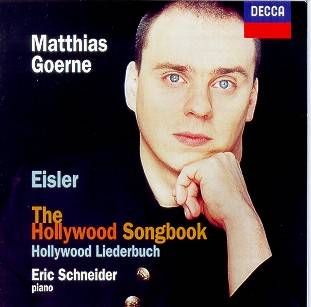
Eisler is one of those composers I have been meaning to explore. I have been intrigued by reviews of two competing versions (CPO and Decca-London) of his Symphony No. 2, Eine Deutsches Symphonie. His music has also appeared on Eterna and Berlin Classics discs. Here, at the other end of the musical scale, are 46 brief ,lyrically jewelled, songs. When I saw the title of the disc I thought of the sophisticated and slightly burly Weill show songs but nothing of the sort. Neither is this a Gershwin songbook. The music is spiritually, 'from the Old Country'. We are used to the nostalgic lyricism of lieder: the wayfaring lad far from hearth, heimat and heavenly delights. The intensifying lens of distance through which the exile views these images idealises them and adds a keen-edged poignancy. This is the currency of the musician and of German romantics in particular. For all of Eisler's socialist credentials it is this Shropshire Lad wistfulness which comes across very strongly in these Schubertian songs written in the USA.
The settings are by the classic poets of the Wolf, Schubert and Schumann eras: Hölderlin, Mörike, Goethe and Eichendorff; but the lion's share of the songs are to words by Brecht (30 of the 47 tracks), a fellow exile in California looking for work and having to compromise artistic standards in order to survive. Some of their shared revulsion of Hollywood and its 'ideals' comes across in tracks 26 and 29. He had escaped from one deadly oppression to another. While one threatened life (contemporary events are shaped by the song Panzerschlacht) the other threatened the soul.
Within Eisler's style the range is quite wide. This varies from the whispers of "An den Kleine Apparatch" [3] to the sterner "Auf der flucht" [7]. Only the piano accompaniment betrays (and then very rarely and subtly) his interest in atonality for example in two Pascal settings [18]. There is an atmosphere of magical entrancement in "Uber den selbstmond" [8] and in [25] a dream dance suggests memories of 'The Land of Lost Content'. Matthias Goerne has the delightful gift, by no means to be taken for granted, of careful balance, variation and shading of dynamics? Listen to way he tiptoes through the notes in "Der Schatzgraber" [28] and plunges deep into the lyrical melos in [22].
Good liner notes and full texts of the songs with translations (a few of the songs are settings of English words). There are so many highlights on this rare and treasurable collection. These include echoing bird calls [41], "Hotelzimmer" 1942 unleashing an unbounded lyricism and the wondering tenderness of Goerne's voice [42]. One of the supremely memorable moments is in "Später Triumph" with its declamatory storminess ending in a great Hokusai wave brought into our homes by Eric Schneider's vivid pianism.
Reviewer
Rob Barnett
tar.gif)
Editor's Note: Eisler was amongst the many artists: painters, writers and musicians who fled hostile regimes in Europe for what they thought was artistic freedom in America. Many were drawn by the artistic lure of Hollywood. Only a few were as successsful as Erich Wolfgang Korngold and Franz Waxman who had escaped Nazi tyranny in Vienna and Germany respectively. Fellow Austrian Max Steiner had arrived in America much earlier in 1914 as an emigré looking for a job in the music business in New York. Schoenberg, Stravinsky, Thomas Mann and many others lived in exile in Holywood, some made a fortune but most lived in conditions bordering on penury.

| Hanns EISLER
Orchestral suites Nos: 2 - 5 and songs
Ensemble Modern, chansonnier and conductor, H K Gruber. 74321 56882 2 [70:03] |
|
|
See also Hanns EISLER Orchesterwerke 1 [Suites for Orchestra Nos. 1 -4 ; |
|
|
This new CD of music for silent and early sound films is of interest to film music enthusiasts for several reasons. First, little music survives from the European films of this period. Second, it includes documentaries - for which we have hardly any music. And, lastly it celebrates a "lost" film composer, a musician of considerable ability.
Eisler was a wonderful writer for voices, as we are now rediscovering with his Hollywood Songbook, his choral Deutsche Simfonie and his songs for the plays of Berthold Brecht - a few are included on this disc. He was also a talented orchestral composer but most of all he was a musician who believed that music should be at the service of everyone. Sadly, he had the great misfortune to be a German, a Jew, a communist and working in the middle years of this century. Consequently he managed to fall foul of the Nazis, the US un-American Activities Committee and finally, the East German Communists during a creative and productive life. A rotund and smiling little man, sometimes he had little to be happy about.
If he is known by film music lovers at all it is usually for the scores he wrote for RKO studios in Hollywood from 1943 to 1947. Or for his co-authorship of the 1947 book, Composing For the Films. Yet he had begun scoring in Germany in 1924 for a Walter Ruttmann experimental film and the Suites on this disc represent his main work immediately after that.
In Suite No. 2 the music from the 1931 pacifist story Niemandsland (GER.dir Viktor Trivas - all copies destroyed by the Nazis) establishes Eisler's pre-war style immediately. Jazzy, with atmospheric woodwind writing, black and white montages create themselves in your mind.
Suite No. 4 is from a 1932 documentary made by the great Dutch film maker, Joris Ivens. Called Pesn o gerojach in Russian [Heroes Song], it celebrates the Magnitostroj mines in the Urals. Eisler uses (as was usual in Soviet filmscoring) local songs as his inspiration. The result is a mixture of marches, heroics and jazzy Jewishness, both lively and tender.
Trivas is also the director for the 1933 French production Dans les Rues, which provides the music for Suite No 5. Its eight sections display a more reflective side to Eisler's writing to contrast with the brass scoring of the marches.
All the suites are interspersed with ballads and songs performed in a typical German cabaret-style which surely would have appealed to Eisler, cynicism mixed with a streetwise sadness, The disc's closing suite is No 3 from the 1931 film Kuhle Wampe (GER - Dir.Slatan Dudow). This tale of unemployment in Berlin is notable for being one of Brecht's few film scripts. Eisler's score drives the film along, giving the montage sections an optimism which sometimes contrasts with the events, notably in the 'searching for work' sequence - section [3] of this suite. It ends with an orchestral arrangement of the once world-famous up-beat 'Solidarity March', in this performance suitably bright and manic.
Some of the orchestral works exist on a Berlin Classics disc. But the bounce and tightness of the Ensemble Modern performances with their brisk tempos will appeal to today's audiences. And although the songs have no immediate movie connections as Gruber presents them they add a gutsy supporting period flavour to the whole collection. If you are exploring music as well as movie history this disc will repay your time.
Reviewer
Norman Tozer
tar.gif)
| Edward
ELGAR: In the South (Alassio) Op. 50*. Enigma Variations
Op. 36$. Pomp and Circumstance March No. 5$. Chanson
de Nuit, Chanson de Matin. Op. 15*, The Starlight Express Op.
78^. |
|
|
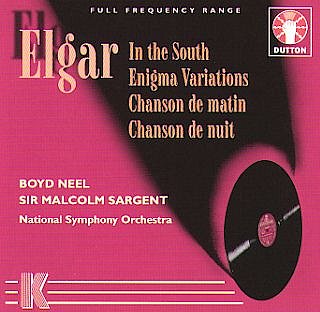
As I listened to the opening bars of this magnificent performance of Elgar’s ‘In the South’, I was continually asking myself why did Decca leave this true Elgarian testament unissued for over five decades. There is a certain ebullient warmth about Boyd Neel’s bold and romantic performance that eluded those before and after him, excepting perhaps those historic records the composer himself made. I make no bones about this, Alassio is my favorite Elgarian work, and nothing written from that majestic pen comes so close to the Mediterranean warmth and joie de vivre that positively implodes the score.
Dutton have conveniently split the work into four distinct sections, the one at fig. 34 is slightly difficult to conceive but the music does retain the natural edge. Decca’s fabled FFRR engineering was at the forefront and one can imagine the hit this recording would have made with its life-breathing violin playing and the various woodwind instrument solos permeating the vast Italian canvas. Boyd Neel is close to Sir Yehudi Menuhin’s excellent Tring account, but that suffers from some over gorging in the slower pieces.
Here the various passages of the work are fused together with a remarkable sense of elan and most of all, a humanity that eludes most conductors. There is no need to make any excuses for the sound, as I said earlier this is sensational Decca at its brilliant best. If Sir Malcolm Sargent’s recording of the ‘Enigma Variations’ is similarly full rounded and brilliant, one must take issue with him for some interpretative points that are slightly controversial. First of all, the performance sounds like a rushed job from the outset with the beautiful Theme lacking in mystery at the swift tempo.
However there are definitely advantages to be had especially in the genial ‘Ysobel’ and ‘Troyte’, both models of Elgarian picture painting. ‘Nimrod’ is a fleeting glimpse from a motor bus; here one almost weeps for the pompous majesty that is to be found in Elgar’s unsurpassable account. Still, all in all, Sargent’s performance is serviceable, but with such a plethora of versions available, he is definitely hard pressed to match the best. The recording is a souvenir of the fantastic National Symphony Orchestra at their brilliant best, one must not forget that there were artists of the like of Dennis Brain in its ranks.
The enticing filler to the original 78rpm set of ‘Enigma’ was the swaggering Pomp and Circumstance March No. 5, this is an ideal and fascinating addendum to the 1953 Decca recordings of Nos. 1 & 4 now available on Beulah (1PD13). Malcolm Walker tells us that the original dates of the actual sessions do not survive, thus continually enhancing the enticing nature of this release. Boyd Neel’s ‘Chansons’ are earlier September 1945 recordings, and in them one can feel the authentic touch that the String Orchestra was able to give to British music. In fact, the soft and silky sweet nature of this salon music has rarely sounded better.
Dutton have chosen to end the compilation with an early, rare pressing of the young Sir Charles Groves in two songs from ‘The Starlight Express’. Henry Cummings clearly enunciated and deeply felt renderings are given sympathetic accompaniments by this much missed character who was to imprint such a firm name on Elgar’s music in the years to come. A treasure trove of a disc, with it’s authentic front cover featuring one of those long lost Decca 78’s and as usual, superbly remastered by Michael Dutton. I still hear those magnificent bars of ‘In the South’ ringing in my ears!
Reviewer
Gerald Fenech
Performance:
Sound:

| MANUEL DE FALLA
(1876-1946) Grabaciones Históricas - Historic Recordings
(1923-1976 commercial recordings, radio tapes and live concert hall
tapes) |
|
|
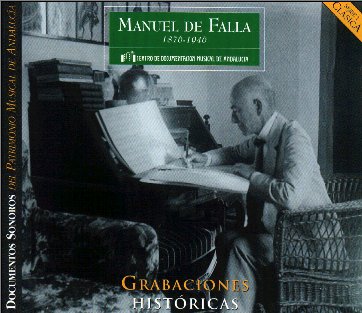
The world has become used to sets of CDs and LPs offering collections of historic (and merely historical) recordings of music by composers who lived in the 20th century. CBS/Sony have celebrated Stravinsky in impressive style. Elgar has had numerous EMI and Pearl sets devoted to his own and others performances of his works. Bartok enjoyed a massive LP set of historic recordings collecting together every scrap of his own performances on several massive Hungaroton boxes. Now it is the turn of Manuel de Falla.
I say 'now'. In fact this box came out in 1996 presumably to mark the fiftieth anniversary of the death of Spain's most famous composer of the century. I do not recall seeing the set reviewed anywhere though it may well have been picked up by Fanfare. I was alerted to its existence when I noticed an advert in Gramophone.
Sound quality is what you would expect from a collection spanning so many years. Oddly enough some of the older recordings come over very well while one or two live performance tapes are of disappointing quality. There are no obvious signs of artificial enhancement of the disc sound. Some 'cleaning up' has been done but nothing objectionable. I cannot however claim familiarity with the original 78s!
I suspect that many of these recordings are quite rare - certainly in the USA and UK. CDs 1 and 2 are all from 78s (1923-40). CDs 3 and 4 are from Spanish Radio archive tapes (1975-76).
CD1 1923-42
SERENATA ANDALUZA (1898-9) was written for violin and piano. This 1931 recording has the work arranged (not by de Falla) as a 'concerto for castanets and orchestra'. It is a light music novelty and in this recording the castanets (properly 'castanuelas') are startlingly in the foreground with the orchestra balanced very distantly. From 1900 comes a charming song TUS OJILLOS NEGROS in a 1926 recording by Elvira de Hidalgo. The crumbly and occasionally distorted sound of Leopoldo Querol’s CUATRO PIEZAS ESPANOLAS (1936) and the 1923 FANTASIA BAETICA at the hands of Mark Hambourg yield little pleasure to me. However the SIETE CANCIONES POPULARES ESPANOLAS with the composer at the piano and Maria Barrientos (soprano) are a very special experience: bright-eyed, eager, it is as if the two artists inspiring each other. This was recorded in 1928 and the two artists returned two years later to record Soneto a Cordoba and Cancion del Fuego Fatuo. There is a raw purity in Barrientos’ voice which I find very appealing by contrast with the more operatic voice of Conchita Supervia whose set of the seven songs appears on disc 2.
The HARPSICHORD CONCERTO (rec 1930) is a wispy piece which can appear quite episodic. The composer is at the keyboard partnered by French celebrity soloists including Marcel Moyse (flute). The concerto comes over as a very intense piece particularly during the ominous ‘hammer-blows’ of the central Lento. Neo-classicism with ripeness and exoticism; not at all the desiccated product it was to become in some compositional hands. PSYCHE (rec 1942) ravishingly sung by soprano Leyla Ben Sedyra is an extension of the exotic world of the concerto. Ninon Vallin’s brief account of Danza del Juego del Amor from the end of El Amor Brujo makes you wish the recording (1927) did not stop just before the climactic bell-haunted climactic delirium of the finale.
CD2
Two major orchestral works here plus the Seven Spanish Songs (Supervia rec 1928-30). Interestingly the complete Supervia set (marred for me by her wide vibrato) is ‘interrupted’ by other singers’ performances of one of the set: Jota. The other singers are Juan Garcia (rather unfeeling and plummy-voiced), Conchita Badia (tender), Miguel Fleta (dark-hued) and Lucrecia Bori (nasal, commandingly intense, vividly accompanied). EL AMOR BRUJO is given a magical performance by Orquesta Betica de Camara de Sevilla directed by Ernesto Halffter (rec 1930). The gusty-voiced soprano Conchita Velazquez lends the performance a wild elation in the celebrated Danza del Juego del Amor and Final. Pantomima (probably Falla’s most inspired melody and unaccountably recalled during Gosta Nystroem’s Sinfonia del Mare) is played with great sweetness although the boozy-toned violin solo is a blemish which the taste of the time probably saw as a strength. The early recording techniques could not accommodate the full clamour of bells which should dominate the closing pages. Although we catch the ringing of cow-bells a la Mahler they are quite muted. NIGHTS IN THE GARDENS OF SPAIN is one of de Falla’s most enchanted and enchanting works. A sinfonia concertante for piano and orchestra, it is taken by the same forces as the El Amor recording and was taken down in the same year. The pianist is Manuel Navarro. The performance is a good one with many poetic moments but it is not more striking than many modern ones. Particular favourites of mine include Soriano, Rubinstein and (brace yourself) Alexander Iokheles. Iokheles is on an old Melodiya LP reissued on Classics for Pleasure with an equally inspired El Amor Brujo. Recording quality of the Melodiya was very raw but what a performance! The piano sound on the 1930s 78s is papery, robbing the music of much of its essential richness.
CD3
Radio Tapes 1956-66 EL RETABLO DE MAESE PEDRO (1923 rec 1966 RTVESO/Ernesto Halffter) is quite a striking work and deserves to be much better known. The 30 minute opera is a counterpart of Holst's Wandering Scholar. The work blends the Moorish exotic (Muezzin calls rather like those in Delius’s pagan Requiem) and a Pulcinella-like neo-classicism. The singing and performance are vivid and here the recording is very clear and bright.
THE THREE CORNERED HAT (Tricorn) is de Falla's world-famous hit: his Enigma, his Planets. The model and some of the musical language is Petrushka but this element is completely overwhelmed by the devastatingly original and coruscating Hispanic brilliance, languor and romance. This performance of suites 1 and 2 (21'20") is by the Orquesta Nacional de Espana conducted by Ataulfo Argenta. While compromised by one of the most distant recordings I have ever strained to hear, the performance is astounding. Argenta captures the subtle changes of pulse, the convulsive power of the wild march, the delicacy and the unbridled Iberian romance of this music. This must have been an extraordinary event with Argenta delivering the music in the style of Mravinsky - incandescent. A pity about the distanced sound - poor microphone placing presumably - however if you turn up the volume you will quickly adjust. It is also a pity that we get only 21'20" of music and that there is distortion on the massive drums at the end of the suite. As it is this is an event (a miracle) we are privileged to listen in to down the years. Just imagine if Argenta had tackled the whole ballet at this concert. The explosion of applause at the end of the suite comes as no surprise. The HOMENAJES (15'30") is four tribute movements in the form of a suite. The tributes are to the musicians Enrique Arbos, Debussy, Paul Dukas and Felipe Pedrell. The suite was assembled and orchestrated from compositions written between 1920 and 1939. The composer's last years were occupied by the massive cantata Atlantida (recorded by EMI in the late 70s). Homenajes seems to have been de Falla's only musical respite from the obsessive work on Atlantida which seems to have become as much of a burden as the eighth symphony became to Sibelius. In any event the muaic of Homenajes is subdued although the first movement has an Elgarian grandeur. This tape comes from the same 1956 concert as the Three Cornered Hat suites. The concert marked the 10th anniversary of the composer's death and was clearly a major event although the fire does not seem to have been in the bones so far as Homenajes is concerned.
CD 4
Radio Tapes 1953-76
Segovia and guitar aficionados will be delighted to have a radio performance of the Master performing de Falla's only work (LE TOMBEAU DE CLAUDE DEBUSSY) written for guitar and later orchestrated and included in the Homenajes suite. The radio tape is of muffled quality but Segovia's delicate and rough artistry shines through. LA VIDA BREVE (1905, rec 1972) is an opera. Here we have a suite for orchestra but with songs from the opera vibrantly sung by Pilar Lorengar. Lorengar's reputation was international and she sang in celebrity operatic productions and in lieder recitals worldwide. Her vibrato is prominent but the raw passion in her voice is patent. The suite is satisfying musically. The choir of RTVE produce a black sound comparable with Finnish choirs in Sibelius Kullervo and Klami's Psalmus. Lastly comes FUEGO FATUO (circa 1916) - a suite of charming though bland dance movements for full orchestra. The suite has no connection with El Amor Brujo despite sharing the title of one of its songs. In fact this is a collection of Chopin piano pieces arranged by De Falla and completed by the conductor Antoni Ros-Marba. The suite is rather conventional. Though charming this not another El Amor Brujo or Tricorn. One for the de Falla completist!
OVERVIEW
There is an excellent trilingual (Spanish-English-French) booklet running to 50 stylish pages. The English section covers 11 pages. The booklet is made all the more appealing by 22 pictures many from the Archivo Manuel de Falla (Granada) and the Fundacion Manuel de Falla (Madrid). There are pictures of the composer and of the many artists recorded here. Congratulations to author Andres Ruiz Tarazona for a densely informative and readable essay.
The set was produced with sponsorship from the Department of Culture of the Andalucian Government. It is part of a series called The Musical Heritage of Andalucia. I hope someone can find out what else is on offer in this series.
This valuable anthology using performers (almost all of Spanish birth) belongs in the collection of all de Falla enthusiasts, students of Iberian music and libraries/sound archives. There are some remarkable musical experiences here (the Argenta Tricorn for one) but anyone buying must be prepared for sound that is often elderly and at best only respectably good. Playing these recordings reminds us of the privilege we have of hearing the composer as performer and of performances which must have shaped and influenced the composer’s attitude to later works. This is an important ‘Dokumente’ and a source which incidentally yields pungent musical pleasures and plunges us deep into de Falla’s world. Track after track offer riches and contrast. De Falla is terribly underestimated and under-known. It may ring false for me (as a non-Hispanic) to say this but when listening to de Falla’s music you feel in touch with the country of his and other times. This is not thank heavens a composer concerned with presenting folk melodies (songs and dances) in their original shape and form. De Falla melds the community music of Spain (particularly Andalucia) into the universal language of Stravinsky and what emerges is new and fresh and in turn has, across the world, fixed a new image of what Spain and Spanish music is all about. If it has also helped consolidate a hackneyed picture (see Chabrier, Ravel et etc) the blazing vigour and honesty of this music shows that the fault lies not with de Falla.
This set educates and enriches but it is not for the hi-fi enthusiast. For those with open minds and a musical inner ear the artistic high fidelity of most of the performances compensates for the occasional surface noise and audio-technical shortcomings. Recommended.
Notes (1) De Falla’s music is one important window onto the Peninsula (and I do not forget Portugal as a separate distinctive entity) nor the regional/separate state character of the Basques. There are many other ‘windows’ including Halffter, Rodrigo, Gerhard, Toldra, Guridi (a particular favourite) and Sorozabal.
(2) My thanks to the generous contributors to the newsgroup who provided so many comparative insights into the world of classic de Falla recordings.
Reviewer
Rob Barnett
tar.gif)
| GABRIEL FAURÉ
(1845-1924) Requiem (1893 version) - world premiere
of version with harmonium 32:20 Pelléas et Mélisande
suite (1898) Op. 80 16.44 Three Mélodies (Dream Sequence)
orchestrated by Douglas Bostock 6:56 world premiere Pavane
(chorus and orch) Op. 50 (1877) 5:53 Pueri
Gaudentes |
|
|
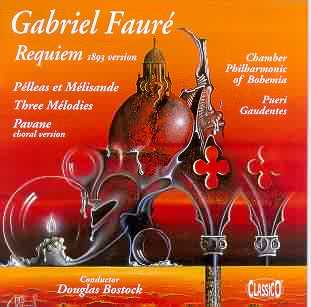
A significant disc including two Fauré world premiere recordings.
The Danish firm ClassicO have been working away unobtrusively and building up a distinctive catalogue. The company founder, Peter Olufsen, has founded the firm on the bedrock of a classical mail order club active in Denmark and Germany. The catalogue is distinguished by some extremely distinctive issues. These include a collection of Rued Langgaard piano music and (soon to be released and, I hope, reviewed here) Niels Viggo Bentzon's massive piano sequence Det Tempererede Klaver. French music has been part of the picture from early on with three discs by the same orchestra and conductor as above, focused firmly on largely neglected French music from 1850-1950 (reviewed last month). I have the highest hopes that they will be tempted to tackle Ropartz's Symphonies 1, 2, 4 and 5. In addition their British Symphonic Collection series (Munich SO/Bostock) promises to bring us many premieres of fabled works from the British musical renaissance.
This disc has its peaks and troughs. It is in familiar territory with the Requiem and in front of withering competition. The authentic harmonium marks out the recording as a world premiere and will make it a 'must-have' for many.
The artistry is beyond most challenges although they use an off-puttingly mournful baritone solo in the Requiem. This is a Requiem, true enough, but I would have expected a little more expressiveness and colour in the voice. Otherwise the performance is easeful and contentedly reflective, raking over echoes and pre-echoes of Verdi, Howells, Finzi and Vaughan Williams. Interesting to note the composer's failure to set the Dies Irae.
The work and performance are intimate in style and the Libera Me is floated with an effortlessness and taste which commands immediate respect and affection. The image of a cold church with clouds of condensation rising from the mouths of the singers is almost tangible. The inevitably tremulous tone of the harmonium adds an attractive homely dimension in contrast with so many 'stainless steel' versions on the market.
The Pelléas et Mélisande suite comprises four movements. The prelude receives a subdued performance without angularity - just a little characterless. The next movement is much more successful, as is the famous siciliènne. Both dance along like Ravel's Infanta: innocence, a light sadness and beauty in equal measure. The final molto adagio is liturgical and has some of the awkward halting qualities of the first movement. This version would not be my recording of choice. For that I would look to the Michel Plasson EMI account. Bostock uses the version which Fauré expanded from Koechlin's pit band original score. You may not know that the Maeterlinck play for which this music was written was performed with this music for the first time in London on 21 June 1898.
The 'dream sequence' is a cycle of three of Fauré's most famous songs orchestrated for small orchestra and harp. Here the baritone solo (Furio Zanasi) is much better at colouring the words and adding expression in a way notably absent from the Requiem. He is still a little soulful but then the songs for which we have the full texts in French and English are languid dreams. Mr Zanasi is rather backwardly balanced but the sound is what you might expect about fifteen rows back in a concert room. The orchestrations are tastefully in style. The songs are: Rêve d'Amour; Après un rêve; Aurore.
The Pavane will be well known to some from the version used on British TV for the World Cup in France in 1998. This has a consistency of atmosphere with the middle two movements of the Pelléas suite. The recording balances the choir rather tacitly against the orchestra. This together with the Sicilienne and the Pie Jesu are among Fauré's most beautiful gifts to a world which came to a shivering and shuddering change in 1914. The ClassicO recording is not afraid to celebrate with restraint.
The recording, which is naturally subdued rather than garishly lit, was made in St Wenceslas Church, Lans-kroun in the Czech Republic.
The 22 page booklet has detailed notes in English only. It gives a considerable amount of background information. The main notes are by the conductor.
The cover art is by the same artist who contributed the surreal pictures which adorn the three ClassicO volumes of neglected French orchestral music.
Well worth your investment, then. Shortish on playing time but Fauré enthusiasts will find much to enjoy in the understatement and the concentration on fine lines and inwardness which pervade and drifts languidly from these performances.
Reviewer
Rob Barnett
tar.gif)
| ZDENEK FIBICH
Hippodamia Trilogy (1889-91) - three melodramas
Plays in spoken (not sung) Czech with continuous music 1. The Courtship
of Pelops Op. 31 (1889) [114:23] 2. The Atonement of Tantalus
Op. 32 (1890) [145:59] 3. Hippodamia’s Death Op. 32
(1891) [144:03]
|
|
|

Jaroslava Adamova - Hippodamia
Eduard Cupak - Pelops
Rudolf Hrusinsky - King Oenomaus
Martin Ruzek - Tantalus, King of Argos
Josef Vinklar - Myrtilus
This massive six and three quarter hour cycle of ‘shock’ melodramas follows the classical story of Hippodamia. The epic story is presented in the form of a radio play with a constant fabric of music underpinning the words and action.
Each of the three handsomely designed sets of CDs comprises two discs and comes with a full set of notes and a booklet of the complete spoken text in both Czech and English. The notes and separate synopsis are in English, German, French and Czech.
What would Richard Strauss have made of this salty gore-stained story? Desire and revenge, tragedy and passion crash and heave like monstrous waves. In Act 1 of the first of the cycle Hippodamia kisses the severed and impaled head of one of her hapless suitors who failed in the contest for her hand. This is years before Salome.
The balance favours speech at some slight disadvantage to the audibility of the music. The two are woven together but the words are the lead component. In other melodramas or orations more prominence is given to the music. I think particularly of Prokofiev’s Eugene Onegin where the rollingly magical text seems to achieve an equal symphonic balance with the, music. This is best heard in the Melodiya LPs (not yet reissued) rather than the atmospheric English language set produced by Chandos.
Fibich clearly invested much effort in Hippodamia and had written three other melodramas what appear now, from this perspective, to be an apprenticeship for this giant of work.
Grove V speaks of the vast complexity of leitmotivs linked to each of the many characters who populate the triptych and whose bodies lie broken and bleeding throughout the great story. Not to worry; the eloquent pleasures of the music are accessible without having to identify and map out these character signposts.
The cast is consistent across the three dramas and so are orchestra and chorus. The more internationally known Jaroslav Krombholc directs the first drama. Frantisek Jilek conducts the second and third parts.
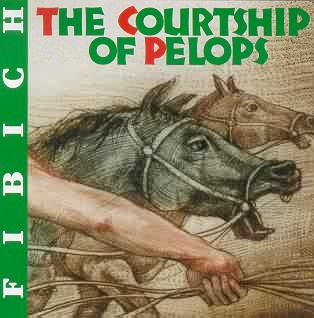
1. The Courtship of Pelops (4 acts)
Jaroslava Adamova; Eduard Cupak; Rudolf Hrusinsky
Kuhn Mixed Choir/Pavel Kuhn
Brno State PO/Jaroslav Krombholc
Pelops arrives at Pisae a city ruled by King Oenomaus. The king has a daughter, Hippodamia. Suitors are put to the test in a chariot race and if they fail are slaughtered and their dripping heads impaled on stakes on the city walls. Pelops set his heart on Hippodamia and she on him. She fixes the chariot race so that her father loses and is mortally wounded. She wishes to rule with Pelops. Wedded, the two return to Pelops’ home and Hippodamia discovers Pelops has a childless wife who Pelops promises to banish. The couple are followed by Myrtilus the charioteer who had conspired to kill Oenomaus and who loves Hippodamia. When it becomes apparent that Myrtilus is in love with Hippodamia and had fixed the race and killed the king Pelops fights with Myrtilus and throws him over a cliff into the sea far below. Pelops and Hippodamia fall into each others arms. This is promising operatic stuff.
The Fibich’s slightly Schumann-inflected language is leavened by the blackest of brass contributions underlining the dark skein of intrigue and lust. The actors are uniformly excellent, intoning the Czech words and investing them with feeling. It is really more like a radio play with a larger-than-life musical score. It is a continuous tapestry of melody rather than incidental music which often comprise brief packets of music here and there.
At end of track 2 (disc 1) listen to the drum-beat which gives forward momentum and suggests fear over Myrtilus’s resentment and commitment to intrigue. Other highlights include the solo violin’s sweet singing in the prelude to scene 3. There is also a great paean of triumph and anticipation to announce the start of the chariot race in which King Oenomaus’s death is planned by Hippodamia who must have Pelops.
The music occasionally sounds like Elgar (would Elgar have completed his sacred trilogy if he had committed to melodrama rather than sung oratorio?). Other ‘voices’ are there too: Brahms, Beethoven, Schumann (quite often), Smetana and Dvorak.
*************
2. The Atonement of Tantalus (four acts)
Jaroslava Adamova; Eduard Cupak; Martin Ruzek
Kuhn Mixed Choir/Pavel Kuhn
Brno State PO/Frantisek Jilek
***************
Vrchlicky (the playwright) wrote Tantalus in the knowledge that it would be set to music by Fibich. The other two parts were written quite independently and earlier. The first to appear was Hippodamia’s Death. Vrchlicky’s play ‘A Night at Karlstein’ was the inspiration for Fibich’s overture (a work which, in its whirling and bubbling champagne energy, is fully the match for Smetana’s Bartered Bride overture) of the same name.
The plot of part 2 continues from where the first melodrama ends and does so without a temporal break. Pelops returns with Hippodamia to his home and his father King Tantalus. He rejects his virtuous and innocent childless wife, Axiocha and with Hippodamia humiliates her in front of the people. Pelops returns to Pisae to put down an invasion. Tantalus, guilt-ridden by his own previous crimes, announces that his kingdom shall be open to any seeking asylum. Axiocha returns and takes him up on this. Hippodamia ensures that she is rejected. Tantalus is racked by yet more guilt. Pelops returns to discover that after her exile Axiocha bore a child but has been killed on Hippodamia’s orders. He promises his wife’s shade that he will protect the child. Tantalus adopts the child. The bloody Hippodamia vows the child shall die but, despite her entreaties, Pelops acknowledges the child as his own. Tantalus dies atoned in his son’s arms.
The second in the cycle launches with a sullen indomitable prelude. The rich interweaving of themes amongst a great tapestry of music continues unabated. There are so many striking effects. Track 12 (disc 1) for example is notable for the cry of ‘aaaah’ which is repeated in tones of increasing resignation and tenderness by the chorus. The orchestra throughout is a grand and large one featuring harp and gong. As for the themes, they are often memorable though the grandiose theme for Tantalus is pompous and hollow (at least partially suitable - the pity is that there is not enough torture in his music).
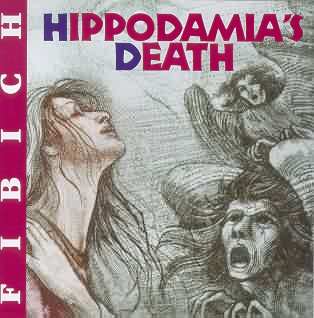
3. Hippodamia’s Death (four acts)
Jaroslava Adamova; Eduard Cupak; Josef Vinklar
Kuhn Mixed Choir/Pavel Kuhn
Brno State PO/Frantisek Jilek
The final instalment of this royal soap (or gore) opera was written first in time by Vrchlicky.
Twenty years have passed under Pelops’ rule. Pelops is now king of Elis. He is married to Hippodamia and they have two sons Atreus and Thyestes, the latter a chip off Hippodamia’s block - thirsty for power, full of treachery and scheming. Chryssipus, Pelops’ son with Axiocha, is favoured by Pelops. Myrtilus returns having been thought to have been slain at the end of part I. Airopa, a hostage princess living in Pelops’ court, is the source of trouble among the three sons. Hippodamia spurs her all too willing sons into plotting against Chryssipus. Myrtilus returns as a beggar like an echo of Ulysses. The games are to be held and against their father’s express prohibition Chryssipus and Atreus enter the games and the games are abandoned. Myrtilus meets Chryssipus and tells him of his father’s crime and the role played by Hippodamia. Chryssipus denounces his mother for the murder of Oenomaus. Atreus stabs Chryssipus who dies but not before cursing Hippodamia. Thyestes draws his knife and finishes off Chryssipus. Pelops is devastated by the loss of his favourite son and be the revelation of a dark secret which only Myrtilus could have known. Pelops determines to find Myrtilus and extract the truth about the plot and whether Myrtilus had been rewarded with Hippodamia’s bed. Airopa, misled by the treacherous Thyestes, leaves the city. Pelops banishes Atreus and Thyestes for the death of Chryssipus. Hippodamia will not support this decision. Hippodamia makes Atreus promise to kill Pelops. Atreus pretends to be Chryssipus and goes in that guise to see Myrtilus. Hippodamia is tormented by her multiple levels of guilt. She turns on Pelops blaming him. Pelops forces her to confess all that she has done and she turns on him with a dagger. Myrtillus refuses to tell Pelops what reward he received for conspiring in killing Oenoamus. Pelops kills Myrtillus. Hippodamia sees her father’s dying curse coming true around her and in despair stabs herself. Pelops leaves to open his palace to the divine retribution of the Furies. All ends in a bleak negation.
Track 3 of CD 1 delivers a grand triumphant ceremonial scene. For the first time we get an impression strongly reminiscent of Dvorák and this returns again in tracks 5 with a grand march hinting at Dvorák’s Symphonic Variations and also in track 13. Track 11 has music of overflowing great tenderness. An odd echo Boieldieu is found in the harp solos in track 14. The music is hyper-romantic with modernistic brass. The textures become more impressionistic and there are hints of mature Tchaikovsky.
The second disc opens by unfolding a shapely Elgarian tune with a dash of Lizst. This is energised by a white-glowing passion and by a waywardness which contrasts with the customarily more uncomplicated Dvorak. The music underpinning track 5 is of similar character but again with washes of Tchaikovsky; witness the clarinet tune in track 5 at 3:23. Turmoil is to the fore in this last part of the trilogy. An uncanny fore-echo of Sibelius’s Pohjola’s Daughter surces in track 9 at 1.25 and the Finnish composer’s first symphony seems about to rear up in track 12. The acting is fully committed coaxing or berating, loving or cold. Overall the feeling of summation and consummation makes this listening experience distinctive and worth the effort of concentration.
If I had to restrict myself to only one of the trilogy this is the one I would choose.
**************
SUMMARY
Fibich is a significant composer who wrote rewarding lyrical music without the revolutionary edge of a Janacek but with a sturdy and often inspired gift for melody and drama. These strong gifts are to the fore in this towering cycle. His orchestration tends towards Dvorák and Smetana but is no empty facsimile of either.
I do not know his operas but would expect them to be well worth the effort. In many ways the Hippodamia trilogy is a counterpart for an operatic cycle. He must surely have wondered about it as a sort of Czech national Ring. Its themes are universal and in their extremes of emotion will hold the attention. The figure of Hippodamia is not a sympathetic one but is certainly commanding. She is in some ways a combination of Lady Macbeth and Balakirev’s Tamara.
Those who would like to learn some Czech (which seems to be precisely though not pedantically enunciated although I confess I do not know the language at all) will, no doubt, find the set worthwhile and would wile away a long journey in the car or on headphones in the train or coach.
The Supraphon catalogue seems quite stable but I would recommend a prompt purchase of this full price set (although each part is I believe available separately) for those at all interested in this lively monument to a fine composer. His music is pretty consistently rewarding and his oeuvre still seems likely to have many agreeable surprises and challenging discoveries for us.
The musical language of the melodramas is tangy but familiar and when mixed with the resonantly acted words makes for a powerful epic experience. Recommended for those who enjoy the Fibich symphonies, Suk’s Asrael and Dvorak. I should also have added that the music is quite Tchaikovskian especially in part 3.
Reviewer
Rob Barnett

| G.F.HANDEL:
FURY WITH RED SPARKLING EYES Dramatic arias by Handel
|
|
|
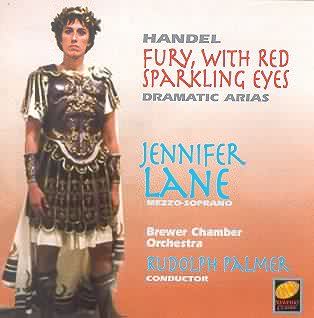
Newport Classics have done much for Handel on CD in recent years, this is a stimulating recital by the American soprano Jennifer Lane, a warm rich voice (but not too plummy to detract from the dramatic qualities of her arias), displaying very good diction and stylish in matters like vocal declarations. Her programme is unusual; we all know ‘Where ’ere you walk’ and perhaps ‘Laschia ch’io Pianga’ from Rinaldo and ‘Si Tra I Ceppi’ from Berenice usually heard sung by a bass but we also have here two fine numbers including the disc’s title aria, from Alexander Balus, maybe Handel’s most rarely heard oratorio, two arias from Muzio Sievola (of which opera Handel composed only Act 3), two superb ones from Faramondo, a late ‘failed’ opera which perhaps we should reconsider (previously I only knew the Overture, also fine), and an accompanied recitative and aria also from Berenice. Dramatic should not be taken too literally as the programme affords plenty of variety.
The Brewer Chamber Orchestra under Rudolph Palmer are vigorous, stylish accompanists and they break the sequence of arias with brief orchestral interludes, taken from Joshua (an oratorio) and Siroe (an opera). Good recording. Worth investigating by Handel enthusiasts
Reviewer
Phil Scowcroft
tar.gif)
| KARL AMADEUS HARTMANN
(1905-63) The Eight Symphonies & Gesangs-Szene
(1935-63)
|
|
|
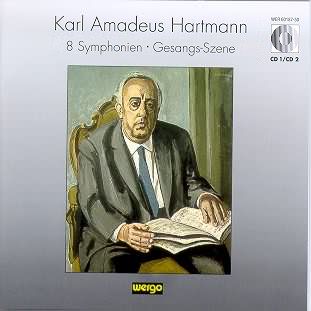
4 CDs in 2 single-width boxes in card slipcase.
Rather like the Donemus set of the Vermeulen symphonies this one from Schotts-Wergo stands as an important document of twentieth century music and an assertion of the vibrant adaptable life of the symphony.
Hartmann's music is predominantly serious with a strong vein of the exotic and impressionism. It is not out of keeping with the lugubrious looking composer portrayed in Adolf Hartmann's painting on the cover of the CDs. The history of many of the works here traces back to earlier works from the 1930s and Third Reich years. There is clearly a great deal more to hear from those years. I hope someone will resurrect the works of that time, or have they all been destroyed? I cannot imagine this music appealing to the National Socialist movement, but who knows? It would be interesting to hear of Hartmann's role in the political and artistic life of Germany.
To return to the Wergo set: documentation is rather sketchy; no biography at all. There are two booklets - one in each of the pair of slimline boxes (I wish more companies would use these elegant boxes: it saves space and materials). The first box has the notes in German; the second in English. The sung texts of symphony 1 and Gesangs-Szene are given in full. The orchestral specifications are listed and there is a technical description of each work. The translation into English is not always a very happy one. The first two CDs run over 60 mins. The others run 50 mins or less. Sadly, precise dates and even years of recordings are not given. The recordings (all AAD) are in very good stereo and date from no later than 1980 when this collection was first issued on LP. I would guess that the earliest recording here would be no older than 1960s. The provenance of these recordings is likely to be from radio and concert tapes.
The Bavarians are conducted by Rafael Kubelik in all but numbers 7 (Zdenek Macal), 3 (Ferdinand Leitner) and 1 (Fritz Rieger). These Wergo recordings should not be overlooked in the current revival of interest in Kubelik both as conductor and as composer.
The competition is not directly comparable. There is a 1990s series of the Hartmann symphonies on German HMV but it is curiously arranged with many of the symphonies coupled with works by other composers. I have not heard any of these CDs. I do have the Koch International CD which includes the Sinfonia Tragica and the surviving adagio from symphony No. 2 all conducted by Karl-Anton Rickenbacher with the Bamberg SO. The fact that it includes the Tragica not offered here makes it an appendix to the Wergo set.
No 1 Essay for a Requiem (1936 rev 1948-50) This, the only pre-WW2 symphony, starts the cycle with an evocation of the apocalyptic chasm. The contralto is Doris Soffel and she has a fine rich voice which does not compromise enunciation, though under strain (e.g. track 4 00:38) she develops a wobble. In any event, the words are here in German and English. The words are by Walt Whitman from Leaves of Grass. Later the sentiments are to be echoed in the much later and even more apocalyptic Gesang-Szene from the end of his life. It might be interesting to hear the first symphony with RVW's 4th or Bax's 6th symphonies. The Hartmann language is still challenging although whether it was still as challenging in its original pristine 1930s version we will perhaps never know. Schoenberg (especially Gurrelieder in this work) was clearly a powerful influence on Hartmann. Sprechstimme is used in the epilogue final section.
No 3 (1949) This is likely to be the same recording as was once issued by Deutsche Grammophon in the early 1960s on a 10" LP. The conductor is Ferdinand Leitner.
At 35 mins this is the largest of the symphonies. It is in two large (18'+17') movements. The first is a largo which opens in chamber music textures - long string lines interlacing. The music is searingly atonal at times but usually intensely and stabbingly lyrical in a way like Tippett's Corelli Fantasia. At 9:35 there is a clear break where the mood and tempo changes. A furious fugal section now takes over and this can seem rather academic but such is the tumult and the flashes of triumph that this impression is soon dispelled. At 12:00 some of the most extraordinary music of sinewy tumult can be heard. At 14:10 an exotic Chinese march appears - charming in its music box evocation. A sprightly little march is decked in harp figures. The movement ends in metropolitan high-wire dramatics.
The second movement adagio opens with a cool balanced trumpet ushering in a steaming march, there briefly and then gone. The trumpet echoes out over meditative harp slashes. This is one of Hartmann's best works. He is at his most imaginative when at his quietest and most impressionistic. Sections like that at 4:20 show Hartmann as the inheritor of the late-romantic mantle borne by Strauss, Schoeck and Marx. The transition from high drama to more cerebral waters between 9:20 and 10:00 is wonderfully done and a key moment in the work. The work resolves itself in quiet and in the same shadows which opened the Largo. This work has a fine finished and rounded feel to it.
No 2 Adagio (1946) This is a single quarter hour structure by turns apocalyptic (the heritage of then recent German history surely), serene and comforting. Much of the music is impressionistic and exotic - almost the Roussel of Padmavati or Evocations. How often this happens in Hartmann. The quieter pools of music are impressionistic, poetic and easier to assimilate. The moment passions intensify and grand tragedy rears up the strings and brass lean on atonalism, screeching (a little like Vermeulen) in pain and loss. This work is very sensuous and French. It makes an immediate impact. Of course Hartmann must gaze into the chasm and this happens at 9:10 and is all the more horrifying for all that has gone before. Even the exertions of the last four minutes are quite French and could well have been written by some pupil of Ravel, Roussel, Schmitt or Koechlin.
No 4 (for strings) (1947) This is a three movement work adapted from an earlier symphony for strings and soprano (1938) the last movement of which was intriguingly entitled Epitaph for a Warrior. I wonder why that movement was suppressed? That last movement was in any event replaced by another Hartmann adagio. The first movement lento assai - con passione (14 mins) serenades calmly with only a hint of tonal sourness. The music has a hint of Tippett's string writing as well as something of Nicholas Maw. The movement ends with a solo violin in an atmosphere approximating to The Lark Ascending. The central movement is busy and buzzing with activity, again recalling middle period Tippett and this time Bartók. The last movement seems anachronism by comparison with its predecessors. The language is more stridently atonal and I am not at all convinced that it works well as a resolution to the symphony.
No 5 Symphonie Concertante (1950) The orchestra used here is unusual: double woodwind, pairs of trumpets and trombones, tuba, and strings (cellos and double basses only). Four movements in about 16 minutes. This is a decidedly Stravinskian work with touches of Dumbarton Oaks, Soldier's Tale, Rite of Spring (the bassoon theme is toyed with repeatedly), Symphonies of Wind Instruments and Fireworks. I was also reminded of Kurt Weill from the Dreigröschenoper Suite. A salty sound - full of intrigue for the ear. Not even a hint of a movement going on too long. The final movement ends in a pugnacious threat from the brass.
No 6 (1952-3) Symphonies 6-8 are in two movements. No 6 was based on a withdrawn 1938 work inspired by Zola's novel L'Oeuvre and premiered in Liège in 1939. It was premiered in Munich in 1953 when it was conducted by Eugen Jochum. Hartmann's striving lyricism is much to the fore and the main vehicle for it is the string section. The language has its roots in French impressionism as well as early Schoenberg and Zemlinsky. The drive is torrential and brass and percussion spur it forward. Dreamy respite comes sparingly in a Debussian haze (8:00 track 1). Side-drum and increasingly ominous brass disturb the dream. The second of the two movements is a toccata of buzzing activity structured around three fugues. Its theme has a sour jollity borrowed from Bartók. Occasionally the string-writing here made me wonder if Tippett had heard the work. The close is replete with landslides of percussion and orchestral piano.
No 7 (1958) This bubbling, bejewelled work was commissioned by the Koussevitsky Foundation. It was premiered by Hans Schmidt-Isserstedt. There is yet more of the eerie jollity and patterned fugal feel - a breathless flood of activity. The second movement opens with a quiet cello solo which the violins soon develop and sing in long high-lying sinuous lines. The symphony is conducted by the Czech, Zdenek Macal.
No 8 (1960-62) The first movement is another of Hartmann's cantilenas. The long-unwinding tune is announced first by solo viola in a passage which sounds positively Holstian. This is a touchingly melodious inspiration. It is appropriated by furious high-tension strings and punctuated by the marimba and stern brass figures. Not for the last time I was reminded of Tippett's style from Priam onwards. The opening of the second movement is a whispered sardonic march with a triumphal skirl and snap the outline of which would not be out of place in mid-period Bax although the sour treatment is very different.
Gesangs-Szene (1961-63) The singer (and speaker) is Dietrich Fischer-Dieskau in fresh voice. The text, printed in full in the booklet, is from Jean Giraudoux's Sodom und Gomorrha. The text is apocalyptic painting an empire grown quickly to splendour and struck down by every form of pestilence and canker, inflation and poison. The vision is one of nightmare and the music partners the text ideally. This is surely an echo of the rise and fall of Nazi Germany although it has something to say about all empires and what follows when they fall.
With the exception of No 1 these are all-post WW2 works written during trauma, disillusion, renewal of identity and recovery. British symphonies written in the 1950s are gradually being rediscovered (e.g. Rubbra and Frankel). Hartmann's are the German counterpart and written against the recent background of defeat, separation under the occupation, nuclear threat and amid reconstruction they have a fascination and much poetry.
The language is romantic in a Bergian way. Hartmann has a deep sympathy for romanticism as well as for strong rhythmic figures. Rarely does the music grind to anything approaching a halt. If you enjoy the music of Frankel, Allan Pettersson or William Schuman you should explore this set. The third symphony is the strongest and most accessible of the cycle but try also the concentrated Adagio symphony.
Recording quality is consistently excellent - detailed, open and life-like (page-turning can be heard in No 7 and a cough or two in No 8) with plenty of impact. Performances are confident and suggest plenty of rehearsal time and players who are inside the idiom. Recommended.
Reviewer
Robert Barnett

HARTMANN A DISCOGRAPHY OF THE SYMPHONIES
Please let me know of any errors, omissions or other corrections.
Symphonies Nos. 1-8. Gesangszene (1963) Doris Soffel (contr); Dietrich Fischer-Dieskau (bar); Bavarian Radio Symphony Orchestra / Fritz Rieger, Rafael Kubelik, Ferdinand Leitner, Zdenek Macal. CD Wergo WER60187-50 (four CD set: 225 minutes: ADD). From LP set WER60086. Symphonies—No. 1 (1935-6); No. 2 (1946) Adagio; No. 3 (1948-9); No. 4 (1947); No. 5 (1950); No. 6 (1952-3); No. 7 (1957-8); No. 8 (1960-62). Symphony No. 1, "Versuch eines Requiem" (1935-6) (Martinu Memorial to Lidice. Nono Canti di vita e d’amore. Schoenberg A Survivor from Warsaw, Op. 46) Sarah Leonard (sop); Cornelia Kallisch (contr); Thomas Randle (ten); Udo Samel (spkr); men’s voices of the Bamberg Symphony Chorus; Bamberg Symphony Orchestra / Ingo Metzmacher. CD EMI CDC5 55424-2 (59 minutes: DDD).
Symphony No. 1, "Versuch eines Requiem" (1935-6) LP Wergo WER 60 061 c/w Gesangszene - presum. the same recording as in the boxed set?
No. 2, "Adagio". (1946) Gesangsszene to words from Jean Giraudoux's "Sodom and Gomorrah". Sinfonia Tragica. Siegmund Nimsgern (bar); Bamberg Symphony Orchestra / Karl Anton Rickenbacher. CD Koch Schwann CD 312952
Symphony No 2 (1946) (c/w Sym 5 plus - Stravinsky - symphony in 3 movements Bernd Alois Zimmermann - symphony in one movement) Bamberg Symphony Orchestra / Ingo Metzmacher Arno Bornkamp - Bariton Saxophon rec 1997: CD EMI CDC 5 56184 2
Symphony No 2 (1946) Rosbaud cond the SWF SinfonieOrch CD DMR 1004-6 Deutsche Harmonia Mundi. Poss same recording is now part of a 4-CD Col Legno set, AU-031800 CD Col Legno
Symphony No. 3. (1948-9) Ives Robert Browning Overture. Bamberg Symphony Orchestra / Ingo Metzmacher. CD EMI CDC5 55254-2
Symphony No. 4 (1947) Franz Andre cond Brussels Radio Symphony strings or INR Symphony Orchestra, Brussels LP ca. 1950 10" mono Capitol-Telefunken LP L-8146
Symphony No. 4 (1947) (finale Adagio Appassionato only) LP DL9769 LP "New Directions in Music and Sound", Contemporary German Music. Nr.1. This LP also has the Finale of Fortner's Symphony (a most distinguished work, the Paganini variations by Blacher, the Capriccio for Orchestra op. 2 by von Einem, and the Furioso for Orchestra by Rolf Liebermann).
Symphony No. 4 (1947) (finale Adagio Appassionato only) reputed DG 78 - no details
Symphony No. 4 (1947) (c/w Messiaen Et exspecto resurrectionem mortuorum). Bamberg Symphony Orchestra / Ingo Metzmacher. CD EMI CDC7 54916-2
Symphonies 4 (1947) and 8 Bavarian RSO/Kubelik LP DG (1968) (different performances from those on the Wergo set) LP DG 139359, in stereo. Recording June 1967. Ever issued on CD? Probably not. If issued on CD - numbers?
Symphony No 5 (1950): (c/w Sym 2; Stravinsky symphony in 3 movements; Bernd Alois Zimmermann symphony in one movement) Bamberg Symphony Orchestra / Ingo Metzmacher 1997 CD EMI CDC 5 56184 2 Symphony No 5 (1950): (c/w 6 & 8) Berlin SO/Gunther Herbig CD Berlin Classics 0090482BC
Symphony No 6 (1952-3) cond. Ferenc Fricsay RIAS Symphony Orchestra, Berlin LP mono Decca Gold Label DL 9861 US release mid 1950s? LP Reissued 801 Deutsche Grammophon Gesellschaft (c/w Egk: French Suite after Rameau. RIAS Berlin, Ferenc Fricsay. (ca. 1957?). This is Nr.2 in the series "New Directions in Music and Sound", Contemporary German Music.
Symphony No 6 (1952-3) (c/w Berg 3 pieces for orchestra op 6; Webern 6 pieces for orchestra for orchestra op 6) Bamberg Symphony Orchestra / Ingo Metzmacher 1996 CD EMI CDC 5 55612 2
Symphony No 6 (1952-3) (c/w 5 & 8) Berlin SO/Gunther Herbig CD Berlin Classics 0090482 BC
Symphony No 6 (1952-3) c/w Berg : Wozzeck - three pieces BRSO, Kupper(s) (1955) Dallapiccola : Two pieces for Orchestra BRSO (1955) Erich Kleiber/Bavarian Radio SO CD Stradivarius STR10084
Symphony No 7 (1957-8) Bamberg Symphony Orchestra / Ingo Metzmacher (c/w Symphony No. 8) CD EMI CDC 5 56427 2 1997
Symphony No 8 (1960-62) Bamberg Symphony Orchestra / Ingo Metzmacher (c/w Symphony No. 7) CD EMI CDC 5 56427 2 1997
Symphony No. 8 (1960-62) Bavarian RSO/Kubelik LP DG (1968) (different performances from those on the Wergo set) LP DG 139359, in stereo. Recording June 1967. (world premiere No. 8 1962 conducted by Rafael Kubelik at Cologne) Reissued on CD? in DG Collectors series 1985?
Hartmann Symphonies No 8 (1960-62) Leipzig RSO/Herbert Kegel (c/w 5 and 6) CD Berlin Classics 0090482BC
*************************************
Your corrections and additions very much welcomed.
Footnote in the Metzmacher series:-
Gesangszene Sodom and Gomorrah; Miserae Gesangszene: Wolfgang Schoene Baritone; Hermann Pfister flute solo Bamberg Symphony Orchestra / Ingo Metzmacher. (c/w Dallapiccola Canto di Liberazione with Chor des Sueddeutschen Rundfunks and the RIAS Kammerchor) 1997 CD EMI CDC 5 56468 2
compiled by Rob Barnett from information supplied by many contributors to the rec.music.classical.records newsgroup. June 1998
| Joseph HOROVITZ
Trumpet Concerto; Oboe Concerto; Jubilee Serenade;
Sinfonietta;Canzonet; Rondino.
|
|
|
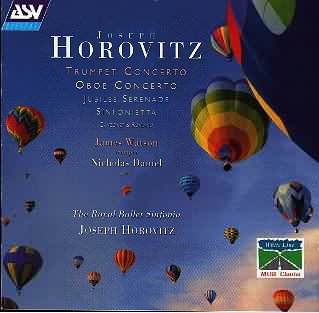
Joseph Horovitz was born in Vienna in 1926 but came to live in England in 1938. Since the early 1960's he has been Professor of Composition at the Royal college of Music, of which he is a Fellow. He holds two Ivor Novello Awards and in 1996 he received the Gold Order of Merit of Vienna. His works include twelve ballets, notably Alice in Wonderland, two one-act operas, nine concertos and music for orchestra, brass and wind bands; plus chamber music and choral works including the spoof, Horrortorio (for the Hoffnung concerts). He has also composed scores for Son et Lumière productions, theatre, radio and over 70 TV plays including Agatha Christie and Rumpole of the Bailey dramas.
This is a collection of some of his accessible, short, genial works.
The Sinfonietta (1971) begins with an exuberant, Allegro that darts engagingly hither and thither. It is followed by a slow and more dignified hymn-like movement. High spirits are rejoined in the rollicking tarantella-like Con brio finale. The Oboe Concerto (composed as recently as 1993), played with keen sensitivity by Nicholas Daniel, begins in pastoral mood with, as Horovitz describes in his CD booklet notes, "the solo moving swiftly, sometimes quirkily, like a fast brook through meadow and woodland." The middle movement returns to the hymnal, contrasted with passages where the oboe rhapsodises over almost static string material. The finale is a jolly, dancing rondo which has rustic associations at first but then swings through oddly assorted styles evoking - "Victorian music-halls, Parisian salons or Viennese band-stands." The light-hearted Jubilee Serenade (1977) is scored for strings with pairs of oboes and horns and is another quaint mix of styles. It is written basically as a neo-classical work with the energetic first Allegro movement, reminiscent of Holst in this vein. The second is a lovely Andantino with the oboe singing a pastoral song over pizzicato strings. The Allegretto is fun: it features horns in calypso rhythm while the Finale's fugue is nice and jazzy.
James Watson's virtuoso trumpet playing sparkles in Horovitz's extrovert Trumpet Concerto (1963) scored for full orchestra. The outer movements are brilliantly colourful but I was drawn to the beautiful poignancy of the lyrical Lento moderato slow movement. The Finale is a rondo with some complex rhythmic patterns derived from Latin American music. The remaining two short attractively melodic items, Canzonet and Rondino (both 1956) come from a Suite for Strings and their content reflect their titles.
The Royal Ballet Sinfonia respond enthusiastically to these essentially light music pieces for their composer-conductor.
Reviewer
Ian Lace

| Sidney JONES
The Geisha
|
|
|

Through the years, a whole series of stage plays, operas and Hollywood films have given us a somewhat clichéd view of Japan and its culture - the films include: Sayonara and The Teahouse of the August Moon to name buttwo. The Geisha was one of the earliest such models. It dates from 1896 and is very much in the mould of Gilbert and Sullivan's The Mikado. It was written by Sidney Jones a now very much forgotten composer whose musical style has long since been eclipsed; yet, in the period between the early 1890s and the First World War, his stage productions enjoyed considerable success. They included: A Gaiety Girl, An Artist's Model, and A Greek Slave (which was a precursor of Sondheim's A Funny Thing Happened on the Way to the Forum). But The Geisha - A Story of The Teahouse was his greatest success; it ran at Daly's Theatre, London for an unprecedented 760 performances and in its initial production it starred Marie Tempest as Mimosa and Letty Lind as Molly.
The Geisha, described as a Japanese musical play, is bright and breezy. Its musical style of Victorian/turn-of- the-century lyricism, would be swept into redundancy by the music of 1920s Broadway. From this period, only the music of Gilbert and Sullivan has survived with much success. Yet once attuned to its style, listeners will find much to amuse and beguile them.
The story line of The Geisha is one of romantic and comic complications. The Tea House of the Thousand Joys (run by devious Chinaman, Wun-Hi) - and, especially, its Geishas are a magnet to visiting English naval officers led, on this occasion, by Lieutenant Reginald Fairfax who flirts with Mimosa the Chief Geisha. Fairfax's fiancée, Molly, is not amused and resolves to teach him a lesson by dressing as a Geisha and surprising him.
In the meantime the Tea House is threatened with closure by womanising Marquis Imari, chief of police and Governor of the Province who is determined to have Mimosa to the chagrin of her admirer Katana Captain of the Governor's Guard. Many misunderstandings occur before all the lovers are united happily.
The opening chorus, "Happy Japan" is sunny and jolly and reminds one of the style of the Elgar part songs as well as of Gilbert and Sullivan. Clearly many of The Geisha's lyrics would be considered politically incorrect today such as those in the early patter song, "The dear little Jappy-Jap-Jappy" but they are conveyed with such innocent and irresistible charm that such considerations can be dismissed. Both Lillian Watson as Mimosa and, particularly, Sarah Watson as Molly are excellent they enter into the spirit of the work with enthusiastic commitment and without any trace of condescension. Mimosa's first big number, reminiscent of the style of Edward German, the charming "The Amorous Goldfish" has a nice catchy refrain. Molly, in her first number, shared with Christopher Maltman as Fairfax, remembers her toys in The Toy and amusingly derides Fairfax for toying with the Geishas. Sarah Watson immediately shows her considerable comic and mimicking talents which she later demonstrates to the full when she mimics a kill-joy parrot determined to destroy the love life of two canaries in the delightful Act II comic song "The Interfering Parrot". Molly is also given one of the more risqué songs, "Chon Kina" which she delivers in her Geisha disguise. Lyrics like - "And if my art entices, Then at extra prices, I can dance for you in quite another way" may seem surprising but then they were the Naughty Nineties! Richard Suart is in great form as Wun-Hi singing such tongue-twisting numbers as "Ching-a-ring-a-ree". Maltman and the chorus have their turn to shine in "Jack's the Boy" a sly and salty song with an engaging refrain about a roguish sailor with a girl in every port. The ensemble pieces are very clever and amusing too. Take the concerted piece, "We're going to call on the Marquis", when the company plan to have their revenge on the overbearing Police Chief It has all the hallmarks of the best of G&S and German.
Ronald Corp can add this sparkling album to the growing number of first class light music albums he has recorded for Hyperion
Reviewer
Ian Lace
tar.gif)
| ARAM KHACHATURYAN
(1903-1978) Violin Concerto in D minor [14:50];
[11:53]; [9:20] Leonid Kogan (vn)/Grand
SO/composer
|
|
|
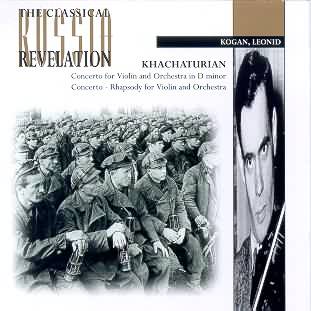
This fascinating mid-price (UK) disc offers a feast of playing by Leonid Kogan. Unlike David Oistrakh who recorded this concerto at least four times, Kogan did not have such a high profile in the West. His various commercial recordings are a comparatively small resource though well-respected and loved. I recall with great affection his Philips recording of Saint-Saens Havanaise: liquid melody flowing like quicksilver and a strong exoticism. There is also a very strong recording (transferred to LP?) of the Tchaikovsky concerto with Silvestri conducting the Paris Conservatoire Orchestra.
Both the Violin Concerto and Khachaturyan have been much vilified for easy accessibility and for a slightly brazen quality. These are matters of taste and taste is often swept along by fashion. The Concerto comes from 1939 when the 37 year old composer was riding high on the success of his flexatone-featured piano concerto (1936) and the music for Masquerade. This (presumably) mono recording dates from 25 June 1951 when the composer was 48 and Kogan 27 and is part of the vast cache of USSR radio broadcast tapes on which Revelation can draw. The recording is clear but balanced succulently close to Kogan who seems to relish every moment with throaty tone, flying sparks and a joyous relaxation into the composer’s richly (but always pellucid) orchestral textures. There is a certain boxiness to the recording but this is not unpleasant. The concerto won Khachaturyan the Stalin Prize (his Song of Stalin dates from two years previously) and rapidly found fame and multiple performances across the world. The first movement, even during the extended cadenza, has a consistently motoric energy. Those who know this Armenian composer through the Spartacus ballet score and the Onedin Line (this will mean something to British readers) theme will hear strange pre-echoes of this throughout the first movement.
The second movement, marked andante sostenuto, is largely introspective, incongruously mixing elements of a rocking lullaby with a far from innocent serenading which looks towards Balakirev’s Tamar and First Symphony. There are a number of blaring explosive passages which have a Steiner or Rózsa-like shabby grandeur. The last movement opens in raucous activity accentuated by the up-close rich recording. The violin melody soon dances and glitters away - strong on a sort of hiccuping charm. As ever with Khachaturyan melody is never far away; when tunes, usually of an eastern exotic caste intrude you are never surprised. The Concerto ends in what I have to concede is a series of rather hammy stuttering hammer blows.
Let me suggest that this concerto is grouped with the Korngold and even the Walton. The latter dates from the same year. The Bax concerto (1937) which bids in the same direction was written for Heifetz. The Barber concerto (1940) is another parallel. They are all sumptuously romantic. They also have an exotic strange Hollywood bloom to them although they established the mood long before California tapped into it.
The Concerto-Rhapsody is in a (more open) recording made on 3 November 1962 and presumably is in stereo though I find it difficult to tell. It is one of three single-movement concerto-rhapsodies - one each for violin (1960), cello (1965) and piano (1955). Kogan here has feverish excitement to tackle and pyrotechnics. As the title suggests the work is more a fantasy than anything else: full of mood-shifts and some echoes of early works. It is a disappointment that he does not draw on the guileless distinctive tunefulness of the 1930s (try the Symphony No. 1 in the ASV Tjeknavorian CD) but things have moved on and the flame does burn brightly at about 15:00. There are many imaginative touches here. This is a work worth hearing but be prepared to give it several listens before it begins to hold you. This is a concert performance though the presence of an audience is betrayed once by a cough and by a burst of applause at the close.
Recommended for violin fanciers and for the growing ranks of Khachaturyan collectors. Kogan is a very fine violinist. He died at the age of 58 on a train during a concert tour of the USSR. I for one hope that there are more examples of Kogan’s artistry to come from the radio archives. A disc coupling the three concerto-rhapsodies would also be of interest.
Reviewer
Rob Barnett

| MARTIN KISZKO
The Battle of the Sexes OST (1999) Incidental Music
to the BBC wild life documentary series on The Natural History of Sex 18
tracks.
|
|
|
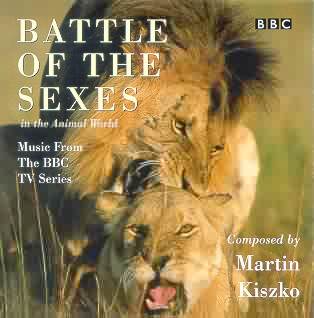
Martin Kiszko has previously contributed highly effective music to the British TV series Alien Empire, The Realm of the Russian bear and Land of the Eagle. Here his music graces (and that is the word) the BBC Natural History Unit’s latest 6 part documentary which examines the sexual act in all its forms. Kiszko assisted Edward Williams in the score for David Attenborough’s Life on Earth series from 1980.
The title track is stormy and features a grand theme. A whooping clarinet cutting right through the texture at one point is a very memorable touch. There is a gutsy turbulence in the skirling horns and a hint of what you might call Hollywood ‘Red Indian’ music adding a dimension of threat. In ‘Another world’ (2) there are hints of John Barry but I do not want to take away from the fine inspiration which pervades deeply velvet, romantically tender harp and flute dialogue and gentlest touch of the strings. This also surfaces elsewhere notably in tracks 4 and the final track interspersed with birdsong. Forays And Foreplays (11) has a decidedly Stravinskian tinkling motif which return in track 17. A jazzy, sinuous and slightly sleazy clarinet slides in Gershwinnying fashion up and down the scales in ‘Jazzed-Up Males’. In ‘Reluctant Hunters’ a solemn cello soliloquy takes centre stage. The cool, concentrated and immanent threat in of The Deep comes over strongly in track 10. Track 12 is notable for the insistent little rhythmic figure for higher woodwind. In track 17 Kiszko produces an excellent warlike ‘mongol horde’ type theme.
This is a classy, straightforward and richly impressionistic score which remains entertaining and even when separated from its images.
The notes are good. They include discographic information, compact information about the series by its executive producer, an ideally balanced note by the composer and a profile of the composer. I hope that before too long Martin Kiszko will become a name we associate with feature film scores as well as TV.
Recommended
Reviewer
Rob Barnett

| David LYON
(b.1938) Light
Music |
|
|

Marco Polo's British Light Music series shifts gear as epitomised by the modern painting (a detail from Ian Steadman's Opus 1) on the CD's booklet cover instead of the mainly quaint Edwardian-style illustrations to which we have become accustomed thus far. Yet it should be emphasised immediately that all these works, although quite recent (composed between 1968 and 1981), are all very melodic and accessible.
David Lyon, born in Walsall in England's West Midlands studied at the Royal Academy of Music with John Gardner and was influenced by the works of Mahler, Shostakovich, Tippett and Britten. He has written many pieces for the BBC's light music programmes; plus chamber, vocal and orchestral music. In 1978 he became interested in adult education and returned to studies this time at Bristol University. Since the mid-1980s much of his music has been designed for school or amateur performance involving voices in one form or another.
The programme commences with the Fantasia On a Nursery Song which is a cheery, often cheeky, set of variations on Nick, Nack Paddiwack as they might have been written by other composers such as Rossini, Arthur Benjamin (his Jamaican Rumba is vividly brought to mind), Sibelius (of Night Ride and Sunrise), Nielsen, Richard Strauss, Bartók, Stravinsky and Walton. This work won an Ivor Novello Award.
The enchanting A Farnham Suite for Strings is a beautifully-crafted, lyrical work written in the style of the great English works for strings - Holst and Finzi come to mind particularly. I loved thius little piece. Equally delightful is Lyon's catchy, carefree miniature, Country Lanes which is a wonderful study in varying cross rhythm and changing key patterns as the music keeps pace with the pony and cart.
The Concerto for Horn and Strings opens with an energetic Allegro conspirito. Unusually, the jaunty music winds down through slowing tempos, becoming more and more dreamily introspective as it does so until it, almost, comes to a standstill before the cadenza which winds the music up again. The Lento movement lets the horn weave a sinuous melody over continuous muted string murmurings leading to an impassioned central climax. The Final movement is bright and breezy and taken at the gallop. Michael Thompson rises to the opportunities and challenges of this quirky little work.
The bewitching Fairy Tale Suite is based on Hans Anderson's The Snow Queen. Its story is about a young boy, Kai, who disappears while playing in the snow. His friend Gerda sets off to look for him, encountering on the way, an enchanted garden, a beautiful Princess, reindeer, wood-pigeons, and a mysterious Ice Palace where Kai is held captive by the Snow Queen. Gerda melts the Snow Queen with her goodness so everything ends happily. The first movement, "Once upon a time..". scored for celesta, harp and two flutes creates a remote icy atmosphere and hidden menace as warmer music evokes the children at play in the snow. The jolly and melodic "Snow Scene" complete with sleigh bells, very reminiscent of Prokofiev, continues this playful mood. The style of the Romantic Russian composers informs "Gerda's Lament". The lovely Waltz (The Enchanted Garden) is followed by "Song of the Pigeons", a whirling, gently shrieking little evocation, directs Gerda to the frozen north. "The Ice Palace: Finale" is narrative music, beginning with ominous tremolandi on strings and icy treble percussion chords leading to confrontation and warmer compassionate figures as Gerda triumphs. A very appealing work.
The Overture to a Comic Opera is a rousing and brisk work, very like Walton/Stravinsky, which made me think of the commedia del arté tradition in its impression of merry pranks. Waltz for Strings is an ingenious little piece requiring great precision work from the violins in their high register made more difficult by the constantly varying time signatures and cross-rhythms.
Ballet for Orchestra is the most structurally complex in the collection and it stretches the term light music to its limits. But it is a high-spirited, accessible composition nonetheless. Brass, woodwind and strings tend to be separated out emphasising the contrasts between them and they are often pitched at the extremes of their range. There is hard, spiky almost aggressive edge to much of the music but its energy, dynamic rhythms and sharp contrasts engage and retain the attention.
David Lloyd-Jones told me how enthusiastic he was about David Lyon's music, and Lloyd-Jones's conviction is clear in brilliant, committed performances. I was very impressed with this collection.
Reviewer
Ian Lace
Performance

Sound

| CZESLAW MAREK
1891-1985 Orchestral Works Vols
1-2 |
|
|
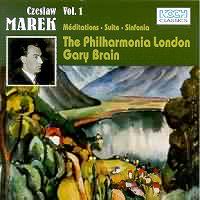 |
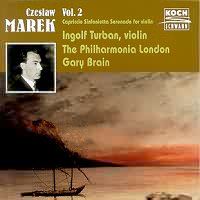 |
Czeslaw Marek was a name new to me until the issue, a couple of years ago, of these two CDs.
He was born in Przemysl (a town - now in Poland - in the then Austro-Hungarian empire) in 1891. A patron paid for Marek to study in Vienna with Leschetitsky, Guido Adler and Karl Weigl (about time someone recorded his violin concerto and symphonies). He moved to Strasbourg and studied with Pfitzner. War forced an eventual move to Switzerland where he took up citizenship. His music is late-romantic with, as he said, a classicist orientation! He was very active as concert pianist. As the world found less time for his music he became increasingly withdrawn and depressed. His MSS are in the central library in Zurich which runs the Marek Foundation promoting Marek’s own music (hence these CDs) and that of Swiss composers born pre-1892.
The five-movement Suite for Orchestra has a Fauré-like gentility and a sad beauty. Amongst its five movements I expected to find a pavane alongside the Prelude - Sarabande - Burla - Gigue - Presto. The textures are more airy and less complex than those of Schmidt, Schoeck or Marx. The Burla third movement has distinctly icy Russian accents. It is played here with a stamping vividness as are the last two movements. The final Presto might have escaped from the glisteningly ecstatic pages of Szymanowski’s dreadfully under-rated ballet Harnasie. Here the atmosphere is enhanced with some Rimskian panache.
Meditations, complete with French movement titles, continues the French influence but here there are even stronger echoes of the lyrical Tchaikovsky (Nutcracker and Souvenirs de Florence) and even of Glazunov with a soupçon of Schoeck and momentary recollections of Sibelius’ Valse Triste. If the sequence ends somewhat inconclusively the music is of great beauty and poise.
Marek’s single-movement ‘Sinfonia’ was an entry in the famous 1928 Schubert competition. This was the one which also attracted Atterberg’s sixth, Holbrooke’s 4th symphony, Brian’s Gothic, Schmidt’s 3rd symphony and Frank Merrick’s symphony. It opens in a dark haze beloved of Bax or Miaskovsky - almost Franckian - and eventually sinks back into the same mystery. From this mystery emerges a bell-tolling climax. Other episodes include Hungarian-sounding dance elements and heady work for the French horns. None of it is very Schubertian but then the competition did not specify pastiche. The notes indicate that the Marek work jostled with the Brian, Atterberg and Schmidt in the Vienna international finals. The work has a strong profile and is very distinctive combining the wildnesses and some of the delicacy of Szymanowski, Florent Schmitt and Uuno Klami.
Volume 2 opens with the 10-minute Capriccio - a dance fantasy. This time the Germanic atmosphere is stronger and I thought several times of Siegfried Wagner’s delightfully varied violin concerto (CPO). There is a gentle Brucknerian lilt to this music lightened by impressionistic textures and Polish/Russian gestures.
The Serenade for violin and orchestra is Delian in its accents and this should not be surprising given that Delius’s many successful performances before the Great War were in Germany under the baton of such conductors as Hans Hayms. There are echoes here of the Delius suite and concerto for violin and orchestra. Other comparative references include the Schoeck violin concerto (1907) although the Marek work has little in the way of Brahmsian influence. Although the four movements do have their moments of intensity and high drama, overall, the work is well named as a serenade, perhaps capturing some of the same spirit as the Bruch work of the same name and specification. The music is charming, reflective, brisk and shapely, all ably articulated by soloist Ingolf Turban and his equal partners.
The three-movement Sinfonietta is plush and romantic. In fact this is the most dense, old-fashioned and least impressionistic of the works featured in the two volumes. Overtones of Richard Strauss, Reger, Pfitzner and occasionally Korngold are to be heard in the first movement. I found it the least convincing of the works here though certainly with some magical moments in the second and last movements.
I wonder what else of Marek’s orchestral work remains to be recorded? Is there a virtuoso piano concerto waiting in the wings? Malcolm Macdonald’s notes (which would have benefited from some proof-reading to eliminate typos) for both discs are always illuminating and thankfully light-handed on technical analysis and heavy on context. This approach is especially valuable with a composer as obscure as Marek.
I recommend these two discs strongly with a definite leaning towards volume 1 if you cannot go for both. They have been well received everywhere. If you were wondering if they were worth getting I hope I have encouraged you. Anyone with a taste for fine melodious impressionistic music with touches of both the French and central European pastoral streams should get these discs before they succumb to deletion.
Reviewer
Robert Barnett
tar.gif)
Notes: 1. Does anyone have a complete list of the thirty works submitted for the final prize in the 1927 International Schubert competition? I would like to see this. There were three works nominated from each of the ten world zones. I would like to see the complete list but am particularly intrigued by the works which emerged from the USA.
2. The Marek Foundation funded the issue of various Schoeck archive tapes on Jecklin.
| CZESLAW MAREK
(1891-1985) Vol. 3: Rural Scenes - seven songs for high voice and orchestra
(1929) Village Songs - seven songs for high voice and
orchestra (1934) Polish Hymn (1975); Death
Melody (1924); Greeting (1924); A Look Backwards
(1911) (a cappella male
chorus) |
|
|
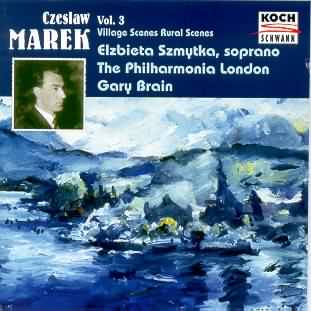
The two previous volumes involved orchestral music, in one case with a solo instrument. Here the human voice is centre-stage.
Marek may be unknown to you. If you enjoy Szymanowski’s shimmering impressionism you will warm instantly to Marek (a fellow Pole) and his music.
Sandwiched between four choral pieces are two song cycles with orchestra. The first Rural Scenes opens playfully à la Canteloube - in fact the Frenchman’s Chansons come to mind quite often. The second evokes the dreamy high pastures and features a dreamy flute. The third returns to playfulness with something of the innocent joy of Rachmaninov’s Wedding Bells (The Bells). A floating cloud settles trance-like over the fourth song. The fifth song is a pizzicato celebration and the final song has great dash and rustic charm.
The Village Songs are more complex than the Rural Scenes. An occasional unknowing parallel is struck with Samuel Barber’s Knoxville (and what a gem of a scena that is!). The final song brings the cycle to an explosive close.
The a cappella choral pieces are a varied bunch. The simple and affecting Polish Hymn has the warm and rounded contours of singing emerging from the Welsh valleys. Similar qualities appear in the Death Melody but this has a passionate climactic episode. Last piece, The Alps-A Look Backwards, is a six-minute work from 1911 - amongst the earliest of the compositions to be approved by Marek. The style is similar to the other choral pieces. The lines and the singing are smoothly undulating and there is a similar spirit to the choral music of Delius (Mass of Life), Richard Strauss (Deutsche Motette) and Othmar Schoeck (Postillon).
Texts of the songs and choral pieces are presented in German. Marek set these in the original Polish (and they are sung in that language) but, inexplicably, the Polish is not printed at all. The ‘translations’ of the German are, in most cases summaries. Perhaps there were copyright problems. In any event this is a regrettable blemish.
The complementary notes by Malcolm Macdonald are good and are in English, French and German.
I wonder how many more Marek volumes there are. Anyway this one is very highly commended and the strongest and most enjoyable of the trio. A must-buy for anyone who is in the thrall of the Canteloube Songs of the Auvergne or the orchestral songs or Harnasie of Szymanowski.
Reviewer
Rob Barnett

| FRANK
MARTIN (1890-1974) Golgotha - Passion Oratorio
(1946)
|
|
|
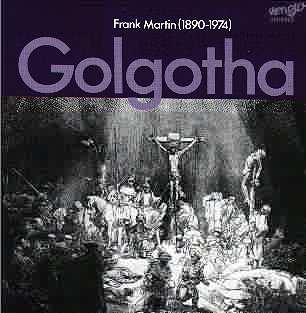
Frank Martin (a Swiss composer for anyone who has not heard the name before - not an obscure Brit ) wrote this piece as a passionate liturgy for his church. His approach was no doubt influenced by his religious upbringing where his father was a missionary and the family was staunchly Protestant and of Huguenot stock.
Martin has a clutch of vocal works to his name. These include a big song cycle for soprano and orchestra (Rilke's Cornet), the unaccompanied Mass (doing very well on Hyperion), the Requiem (available on Jecklin), In Terra Pax conducted by Ansermet (Decca-London but long deleted?) and the big cycle based on the Tristan and Isolde legend Le Vin Herbé for twelve solo voices and an octet including piano (the latter recorded on Jecklin although there is at least one new recording recently issued but unheard by me).
This sprawlingly impressive and serious choral work was begun in 1945 and completed in 1946. It is predominantly serious, written in a sombrely overcast tone. Golgotha is big and of awkward length for the CD. It plays for about 95 minutes in total. The two CDs used here are of approximately equal length. The work follows the Calvary story using a web of Gospel recitative and the meditations of St Augustine. The Bible texts are allocated among the soloists and at climactic moments the choir joins in.
Golgotha was inspired by Rembrandt's etching 'The Three Crosses'. From this germ of inspiration occurring as he was completing another choral masterpiece In Terra Pax (to be heard in a classic 1960s recording by Ernest Ansermet) grew the great structure of Golgotha.
The work (and this performance) is distinguished by resolute singing and orchestral sturdiness. Track 3 offers a good example. There is a concentratedly devotional tone but the work has some brighter episodes for contrast. Note track 2 (disc 1) at 4:01 where the choir are lovingly counterpointed with the brass.
The earnest, devotional atmosphere is very powerful and not at all off-putting. Listen also to the first 10 minutes of the second disc. The music is, on the odd occasion, slightly dissonant but what commands the attention is its lyricism. Martin's writing is perhaps comparable with a rather sombre Gerald Finzi or a step onwards from Franz Schmidt's Book of the Seven Seals (also reviewed this month).
Wilder apocalyptic visions are borne up in the great winds (Francesca da Rimini recollections) of Part VII (Jesus before the Sanhedrim) which dissipate to be replaced by a reverential prayer with chorus and female soloists in Augustine's Meditation VII.
Track 3 of Disc 2 at 5:30 has a military tread with a distinct scent of blood in the nostrils and this continues. Prokofiev rather nicely caught the same atmosphere in his almost contemporaneous opera War And Peace. Of course Martin would have had the Second World War very much in mind at the time of writing this apocalyptic piece. Much of the piece is subdued and the Calvary section on disc 2 almost too accurately summons up all the troubles of the world. A dark night of the soul. The work ends in a dancing Finzian lightness with an angelic rondel of the heavens as the complete forces are swept into the golden exaltation of the Martin's Alpine heights.
I am not aware of any other recordings and this one is quite natural and open in quality.
One curious fact for the collector of non-wobbly trifles: Stockhausen was a pupil of Frank Martin.
Notes and text are in German only. This recording has taken a while to reach the UK market having been made in 1988. In the UK Vengo discs are handled by Priory Records.
Recommended if you are in the right mood. If I was exploring Martin's music with the knowledge I have now I would start with the Requiem.
Reviewer
Rob Barnett

| JOSEPH MARX
(1882-1964) Violin Sonata (No. 1) in A major
(1913)
|
|
|

After far too long a period Marx is becoming better known - at least on CD. His (non-music; he was largely self-taught) degree was from the University of Graz but his celebrity and most of his mature life was centred in Vienna. His local contemporaries were Schreker and Korngold and it is Korngold whose auburn flowing melody is often suggested by the music on this disc.
This sonata (here in its world premiere recording) is a massive (hour long) rhapsodic work deeply rooted in the late-romantic world. It dates from just before the Great War. Vienna was the capital of the Austro-Hungarian empire - an edifice no longer able to tell the difference between its high noon and its sunset. However so far as music is concerned the mixed influences of the many nations comprised in the empire made a rich soil. Marx himself had Italian blood via his mother’s side of the family and the bel canto influence is very apparent in this music. The booklet mentions Respighi as a composer recalled in the music of the Marx Romantic Piano Concerto (revived by Jorge Bolet) and the yet to be recorded but absolutely gorgeous Castelli Romani for piano and orchestra. I would also mention Martucci whose music is available on ASV.
Two other composers will come to mind and both have elements of the glorious sunset in their music. Delius (whose music is more Franco-German than it is English) whose suite, violin sonatas and violin concerto seem to be from the same block as the present Marx sonata. The ‘Swiss Schubert’: Othmar Schoeck is also a reference point - try his violin concerto already recorded on CD at least three times. If you already like the music of either of these composers then you must hear this rewarding sonata. The only down-side is the time-span across which Marx’s material is deployed but more of that later.
The music can sound uncannily English - rather like the pastoral Howells (Piano Quartet), Gurney (Western Playland or Ludlow and Teme) and even John Ireland (especially the first violin sonata). More often however the creamy Viennese style asserts itself. Marx like Schoeck wrote lieder and his sympathy for the human voice and for naturally singable melodic lines is apparent throughout the work. The flow of melody across such a long time-span is of course a challenge. This is a challenge which Marx does not completely meet. There are moments when you wonder if the sonata might have been more pleasing if it spanned 45 minutes rather than 60 minutes. That said I would not want to be without the complete work which is of overflowing richness.
Both Ringborg and Blumenthal (a name much more familiar during the 1970s) seem entirely in sympathy with this music. There is no sense of apology here. Ringborn leans into the voluptuous romance of the music - definitely the lead partner. It is only in the final movement when I wondered momentarily whether the artists’ concentration and interest had slipped.
I came to know this music only comparatively recently from a copy loaned by a friend and taken down from a BBC broadcast. The performers there were Peter Mountain and Angela Dale. Their 1970s studio performance was passionate but does not have cohesion to the same degree as the Pavane account. The warm small concert-hall sound on the Pavane disc is very pleasing.
Superb bilingual (English and French) notes by Michel Fleury whose French language book Impressionisme et la Musique (published a couple of years ago in paperback) is well worth seeking out.
Pavane’s design decisions are faultless. The CD and its packaging look good and the notes are beautifully and thoughtfully laid out.
Interesting to note that Marx’s compositions fall into clearly delineated phases. 1911-20 was marked by many songs, solo piano pieces and by a clutch of chamber works. 1920-30 included the orchestral works which we must hear soon and all too few of which are available on CD: Eine Herbstsinfonie (1920), Naturtrilogie (1922-5) and the two piano concertante works mentioned above. We desperately need recordings of the two orchestral works and of the Castelli Romani.
For now I am delighted to see that Pavane are intending a second Marx violin sonata disc (to be issued in March) which will include the much more compact Fruhlingssonate and a selection of piano music.
Once again Pavane, as one of the enterprising ‘minors’, shows the larger companies how to do it. I am convinced that we will see the internationals taking up Marx’s chamber music within the next 5 years. When that happens the Ringborg account will be the benchmark. It will take some beating. Recommended to all enthusiasts of the late romantics and especially those who follow the composers mentioned above.
Reviewer
Robert Barnett

Pavane can be contacted at dewouters.bam@skynet.be. Their catalogue is worth careful study.
| NIKOLAI
MIASKOVSKY (1881-1950) Symphony No. 1 in C minor Op. 3
(1908) c. 42mins State SO of the Ministry of Culture Gennadi
Rozhdestvenski |
|
|
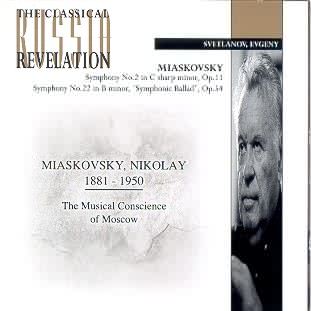
GENERAL
Miaskovsky is a fascinating composer with a strongly lyrical talent naturally nostalgic and perhaps a little old-fashioned in his language. Unlike his close friend Prokofiev he did not go in much for experiments or obviously new directions. Miaskovsky’s music is definitely worth exploring. There is a big, brilliant Violin Concerto offering a well judged mix of poetry and drama. The twenty-seven symphonies are full of interest and fascination. We know too little of this mountain range of works.
There are currently two Miaskovsky symphony CDs in the Revelation catalogue. The other one (Symphonies 2 and 22 both conducted by Svetlanov) is also reviewed this month. In the present CD we have one large-scale epic early symphony and another from later in his career although in the case of RV10069 the other symphony dates from only 11 years later and with its roots in the Great war rather than the Great Patriotic War of the 1940s.
Symphony No. 1 dates from Miaskovsky’s third year at the St Petersburg Conservatoire when the composer was 26. It was revised in 1921 and presumably it is that version which is recorded here. Some years ago a Russian Disc recording of the symphony with similar timings came out coupled with Miaskovsky’s Symphony No 19. That version was again conducted by Rozhdestvensky with an orchestra with only a slightly different name. I suspect that it is the same performance. The only other recording I know about is the BBC radio tape by the Ulster Orchestra conducted by the late Bryden Thomson. There were rumours (it was announced in small print in Gramophone) of an Olympia disc coupling symphonies 1, 15 and 21 but when I checked some years ago with Olympia there were technical problems with the digital mastertape and this has never been issued.
Symphony No. 1 has a striving and striding first movement with much ‘sturm und drang’. If I had to call in any parallels it would be Tchaikovsky of the fifth symphony and of Manfred. There is that feeling of a pilgrimage of the spirit through an oppressive clouded but dramatic landscape. It is also intriguing to hear music in this movement which reminds me very forcefully of the angst-ridden music of Prokofiev’s Eugene Onegin (does anyone out there have the Russian Melodiya version of that play with Prokofiev’s music?). The second movement is an expansive larghetto dominated by a meandering long-breathed theme for the strings with violins crying to the heights. It is projected with passion in this recording.
The last movement already displays all the usual hallmarks of Miaskovsky symphonies. The jerky, noble, aspiring march-like figure has brethren themes in the later symphonies. Glazunov is evoked from time to time and the confidence of this music won Glazunov’s praise at its premiere when the elder composer praised it for its ‘maturity of thought’ and even went out of his way to secure for the young composer a small stipend.
The symphony does not feel like an immature work although there seems to be a higher charge of electricity in the second symphony. I have always liked Rozhdestvensky’s music making. His years in the late 70s and early 80s as Principal Conductor of the BBC SO marked some of the best repertoire days of the orchestra’s history. I recall so many performances. His Prokofiev Chout (full score) performance at the 1979 Edinburgh Festival had narration by Andrew Cruickshank (the original Dr Finlay of ‘Dr Finlay Case Book’ fame - at least in the UK). It was televised and I recall Rozhdestvensky’s almost childlike joy in the music - such a communicative and imaginative musician! Then there was a rare performance of Lokshin’s Symphony No 3 setting with bitter violence and lyricism poems by Kipling including a Danny Deever which left the Grainger version well behind. He also directed RVW’s Fifth Symphony and possibly the sixth. His Proms performances of Delius Song of the High Hills and Violin Concerto (Ida Haendel) were also notably enjoyable. I don’t recall him offering any Miaskovsky symphonies with the BBCSO although if he did perhaps someone will remind me.
The Rozhdestvensky performance of the Fifth is new to CD. It was recorded on 12 February 1982. The sound is very acceptable without being startlingly clear. The fifth is a four movement work unlike the three movement First. The first movement opens grazioso - the marking is allegretto amabile but it is not long before Miaskovsky’s darker side draws in one of his most striking upward-thrusting themes. The second movement is heavy with mystery and at 3:40 there is a passage startlingly pre-echoing Tapiola. At 6:24 an elusive but haunting theme returns. The third movement is dance-like (though the dance is heavy-footed - giants in gum-boots) emulating Borodin. Later the dance becomes more charming and elfin - a Slavonic Warlock’s Capriol - well almost! This stamping Russian folk-dance motif is rather Glazunov-like. The last movement is dashing and confident and for me is deeply coloured by Glazunov’s symphonies, the eighth of which had been completed in 1905. The thematic material here, with recollections of material from the first movement, is of the highest distinction. At 1:55 of this movement we can hear a little of what may have influenced Shostakovich in years to come. There is a joyous Easter Fair heartiness (alternating with nobility) about this movement and even at 4:20 a momentary premonition of Bax. At 6:20 the liturgical upward thrusting theme from the first movement returns in tragic crumbling splendour.
When it comes to comparing couplings for the first symphony the Russian Disc offers Symphony No. 19 for military band which is entertaining but does not have the taut concentration of Symphony No. 5. I also have been able to compare the Marco Polo CD of Miaskovsky 5 (BBCPO/Edward Downes) and the Olympia CD with the old (1960s) recording by the USSRSO and Konstantin Ivanov. No. 5 is a fine work and enjoyable in any of these recordings however for me the Ivanov performance with its single-minded dedication and vibrant (though dated) sound and performance is still marginally the front-runner.
To summarise: buy this CD. Any recording of No. 1 is rare. The Revelation disc should be in easier supply than the Russian Disc version and in any event the Symphony No. 5 is a more attractive coupling. If you are going for a number 5 then you cannot really go wrong with any of the versions though my preference is for Ivanov on Olympia - if you can find it. Miaskovsky symphonic completists are destined to get every version as a means of filling gaps in the symphony sequence. The respectable, intense and well-recorded Marco Polo version has Symphonies 5 and 9 in committed performances conducted by Edward Downes.
Opportunists please note that while we dream of a boxed set of the Miaskovsky symphonies by one inspired orchestra, conductor and recording engineer, a street-wise move would plug every gap in the Miaskovsky symphonic canon: Numbers 4, 13, 14, 18, 20, 24 and 26. Please don’t couple these with previously recorded symphonies. Couple them together!
For someone looking for an easier way into Miaskovsky’s world do try the Violin Concerto. There is an Olympia CD of this work played by Grigori Feigin with the USSRSO conducted by Alexander Dimitriev. This is Miaskovsky’s most approachable work barring none.
Reviewer
Robert Barnett

| NICOLAI MIASKOVSKY
(1881-1950) Symphony No. 2 in C sharp minor Op. 11
(1910) Symphony No. 22 Symphonic Ballad Op. 54
(1941)
|
|
|

SYMPHONY NO. 2 (rec 10 March 1986) This is one of his big muscular works. It has never previously been recorded commercially. The three movements run to three quarters of an hour. The first is Tchaikovskian and opens darkly but before long one of Miaskovsky’s vital cantering figures asserts itself and returns throughout the movement to drive it forward. Trumpets and horns bray outrageously (and gloriously) and if I mention Scriabin’s symphonies, Rachmaninov and Tchaikovsky’s Francesca da Rimini and Symphony No. 5 it is only to give you a few reference points. The ascent and scream of despairing pain from the trumpets in the closing bars is staggering.
The second movement is quieter and has a gentle line in faltering lyricism and bel canto. From 7:30 on Track 2 the Russian brass exult in a passage of despairing intensity. The mood is very concentrated and the instrumental lines are beautifully delineated. The movement may well be a few minutes longer than it ought to be but everything is lovingly done. A strange British echo is to be found in the gentle woodwind theme which seems to be about to collapse into Delius’s Hassan music.
The last movement seems about to launch a fugue but soon returns us to the world of heaven-vaulting desperate Scriabinesque climaxes. An angular theme darts back and forward. Trumpets call piercingly and fortissimo from craggy heights. The orchestra seem to have this intense tempestuous music in their bones. Not for once is there any suspicion that this is a time-serving catalogue filling exercise. Another British work came to mind this time: the cataclysmic Bax Second Symphony dating from the early 1920s. At 3:00 (Track 3) there is a theme which will make us wonder how well Khachaturyan knew this symphony at the time he was writing the famous Spartacus adagio. If we are hyper-critical the movement may again go on for longer than its material justifies but it does so gloriously and with no lack of confidence. The ending is perhaps rather perfunctory given all that has gone before.
The precision and unanimity of attack is remarkable in this performance by the State Symphony Orchestra of the Ministry of Culture conducted by the bright-eyed Gennadi Rozhdestvensky. The recording has great depth and amplitude.
SYMPHONY NO. 22 (rec 2 May 1970) This is in a single track of 35:22. Out of primeval depths arises a lightning strike attack by the cascading strings singing briefly a theme reminiscent of Rachmaninov’s third piano concerto. Once again Miaskovsky comes up with one of those cantering open air tunes - this time with something approaching urbanity. We have to remind ourselves that this work was written during the USSR’s Great Patriotic War against Hitler. At 3:40 (track 4) a great theme of nostalgic moment appears. Miaskovsky is a master of subtle emotion. Little wonder if Lara’s theme from Dr Zhivago might well have been inspired by it. The theme returns on solo French horn at 7:00. Svetlanov is something of a Miaskovsky specialist. Listen to the way he paces and accents the gently shuddering progression of the big theme at 9:11. Sheer magic. The following Largo is a miracle of mood-concentration. The strings develop great tension from 20:00 to 23:00 when the braying brass carol over the strings in a moment which recalls moments in the finale of the Moeran symphony. We are held over the chasm again at 24:02 with brassy Mussorgskian grandeur. A quiet fanfare at 26:04 sounds remarkably Baxian leading into a clattery iron-clad decisive march with a warlike oil-stained and cordite-smoking edge. The pizzicato episodes remind me of Rachmaninov’s Symphonic Dances which date from exactly the same year. The raucous march returns topped off with Baxian fanfares. Whirling strings provide a bed for the high trumpets and deeper brass. The trumpets hold the nostalgic theme high up to the sun in glorious but grieving victory. All subsides into an epilogue before shuddering strings and celebratory brass and drums toll out the end of this fascinating work. I wondered about the provenance of this recording. I suspect this was previously issued by EMI during the early 1970s.
CONCLUSION
If you have tried Glazunov and found him rather loose and undemonstrative then give these two symphonies a try. The disc is generously full. At 79:51 it could hardly be more so. Certainly I cannot imagine you having a better introduction. Those looking for a what-next experience after having ransacked Tchaikovsky’s lockers need look no further. These are not time-server performances. They are projected by musicians who take the music seriously and play it in deadly earnest and without hint of apology.
Reviewer
Rob Barnett

PS Now I want to hear the ‘missing’ Symphonies: 4, 13, 14, 18, 20, 24 and 26. So come on Revelation - surely these tapes exist in some dark corner of the Russian Radio vaults? I have never heard any of these in any form. There were rumours about a complete cycle from Rozhdestvensky but nothing seems to have come of this. Any news? Did Mravinsky perform or record any of the Miaskovsky symphonies? Does anyone have any information on this? Are these symphonies played in Russia these days?
There are more >>>>>
![]() COMPETITION WIN
a CD of your Choice from Crotchet
COMPETITION WIN
a CD of your Choice from Crotchet
![]()
 Search the Crotchet database from here
Search the Crotchet database from here
| Discs
on these pages are offered for sale. There is also a page of search
engines from a selection of on-line retailers
here.
Please support this web-site by buying your discs here. Disclaimer: Every effort is made to make sales links to the correct disc but, in the end, you must take responsibility for checking that what you are purchasing is what you want. Some of these discs were not actually available for sale at the time of posting but a link has been made in anticipation of their forthcoming availablility. |
Return to Index